Wyndham Street and Public Art

Wyndham council has a dynamic contemporary public art program. In addition to traditional art forms such as sculpture, murals and mosaics, the contemporary public art also includes digital artworks, interactive new media artworks, performance and sound art.
Wyndham City is home to a large collection of permanent public art. The public and street art includes:
Hoppers Crossing Area:
Seeds of Change designed by Thompson Berrill Landscape Architects (2004)
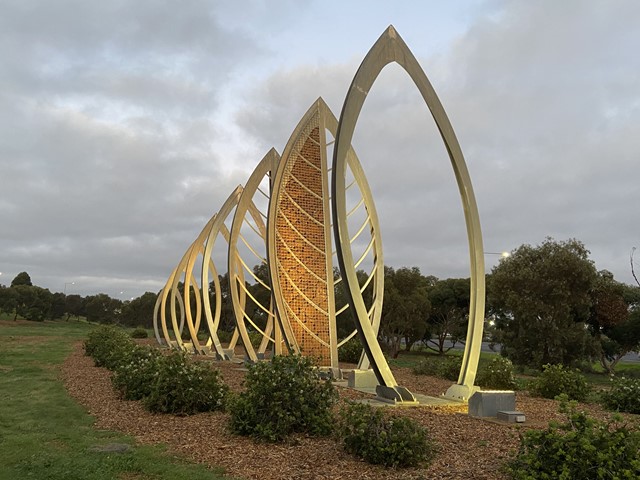
Seeds of Change is a 10 metre high structure designed to welcome home residents, and attract visitors, to the City of Wyndham. The structure enhances the appearance of this gateway and creates a Wyndham icon that symbolizes the community's aspirations for the future.
A project group comprising local artists, an architect, community representatives, Councillors and Council staff oversaw the concept and design development of the structure and residents were invited to submit their feedback.
The design encompasses modern materials such as galvanised steel fabricated to the interesting shape. It features a series of open leaf shape frames, which descend in height. The leading frame features the black and red of naturally occurring basalt rock found in the region. Tall growing sugar gum will frame the site and knobby club rush will surround the structure.
Location: Eastern interchange, Princes Freeway, Hoppers Crossing (off ramp to Princes Highway)
Central Park Community Centre Electrical Box by Veins (2021)
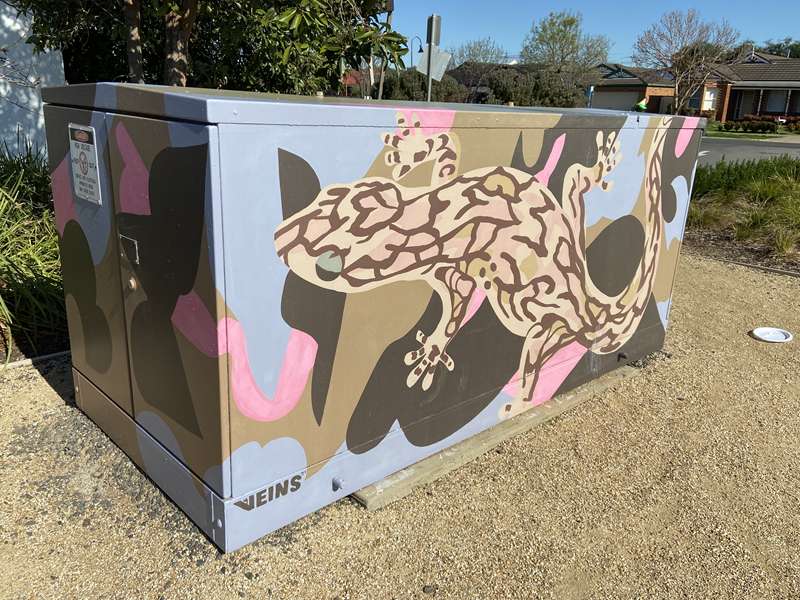
Location: 80 Lonsdale Circuit, Hoppers Crossing
Colours of Life by Clare Bannatyne (1997)
Each glass panel features images inspired by scenes of Werribee South.
Location: Central Park Community Centre, Lonsdale Circuit, Hoppers Crossing
Conundrum by Bill Perrin (2005)
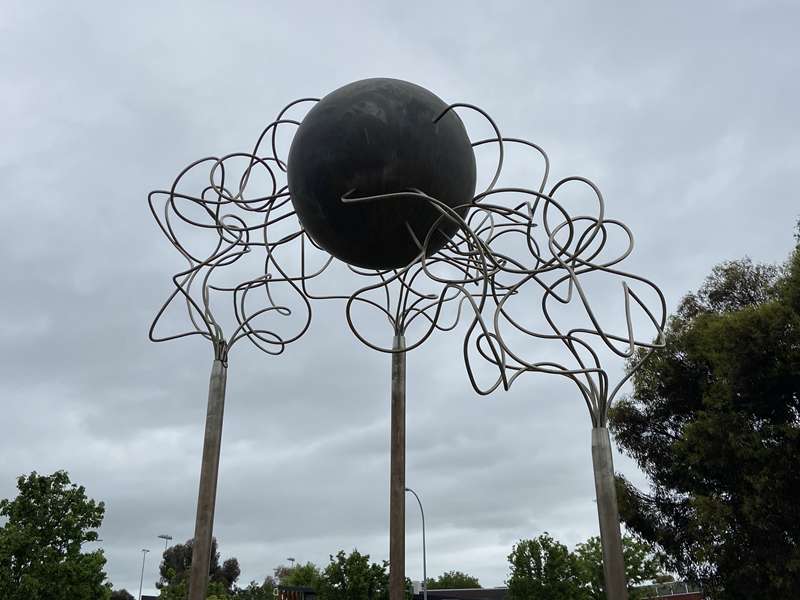
"Conundrum was made to provide a landmark for the local community and in particular to provide a gateway to the Grange Community Centre. The conceptual framework for the sculpture revolves around the symbolic interpretations of the sphere which can be viewed universally as a celestial body or microscopically as atomic particles. The sphere can also be seen as an essential element in the science of motion, as in bearings, wheels, and the use of balls in sport, etc.
"The three vertical stainless steel poles give the sculpture height and verticality. They provide a supportive framework for the linear configuration which exists as a fluid ethereal linear composition which fixes and suspends the sphere in a buoyant state. It is intended that the viewer will respond and engage with the many associations evident within the sculpture.
"The sculpture also reflects the unseen forces of nature such as magnetic and electrical force fields, sound waves, clouds, smoke, etc. This energy is released from the top of the three vertical elements connecting with the sphere. The viewer engages with the physicality of the suspended sphere and interacts with the various associations which it may provide". - Bill Perrin
Location: Grange Community Centre, 260 Hogans Road, Hoppers Crossing
Grange Community Centre Mural
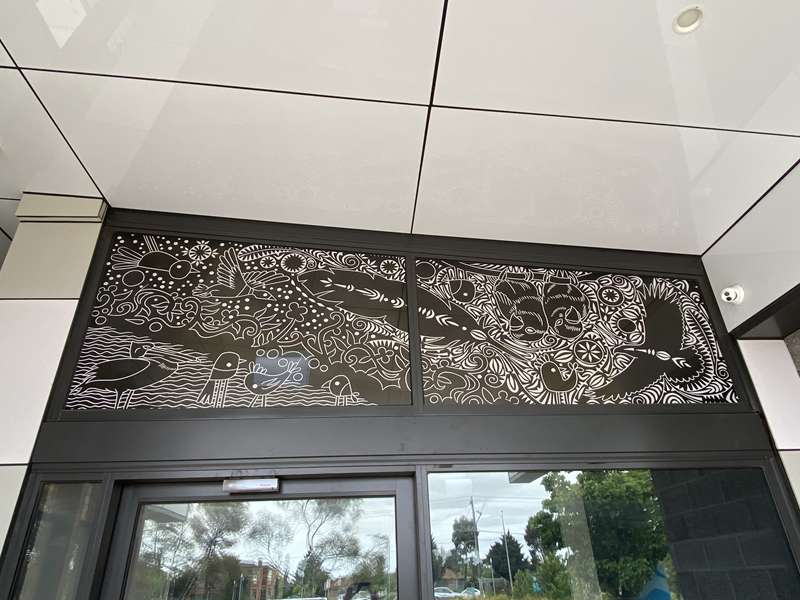
Location: Grange Community Centre, 260 Hogans Road, Hoppers Crossing
Grange Reserve Sports Mural
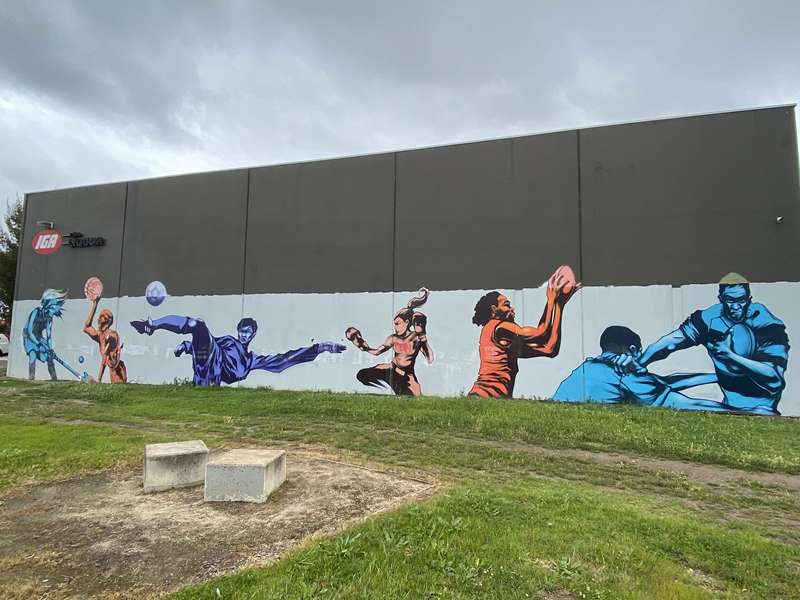
Location: Grange Reserve, 260 Hogans Road, Hoppers Crossing
Signal Box - Paper Barks by Daniel Worth (2017)
.jpg)
This traffic signal box reflects the green areas of Werribee and Hoppers Crossing.
Location: 140 Derrimut Road, Hoppers Crossing
Signal Box - When Animals Escape by Eva Lubulwa (2017)
.jpg)
A piece of work depicting what happens when animals band together and escape from the zoo. It is a creation of fantasy animals through combining animals and playing with colour.
Location: Cnr Derrimut Road and Willmott Drive, Hoppers Crossing
Signal Box - Tumbleweeds by Kevin Fregon (2017)
.jpg)
Houses tumble through the landscape, putting down roots before being blown away again and replaced by the trees they original displaced.
Location: Cnr Heaths Road and Mossfiel Drive, Hoppers Crossing
Manor Lakes Area:
CAT by Dean Bowen (2012)
.jpg)
The CAT is a whimsical character evoking curiosity and fun - and he lives outside Wyndham Vale Community Learning Centre. He has affectionately been nicknamed as 'Learny'.
"The Cat has been an important and ongoing subject in my work for a number of years. As the Community Centre is surrounded by three schools, my aim was to make a sculpture that would engage and speak to one of the main users of the building, the children. My humorous and oversized interpretation of the cat draws inspiration from ancient Egyptian art as well as childhood and adult memories of many amusing encounters with these thought provoking creatures" - Dean Bowen
Location: 86 Manor Lakes Boulevard, Manor Lakes.
Point Cook Area:
Circular by Stephen Banham and Christine Eid (2010)
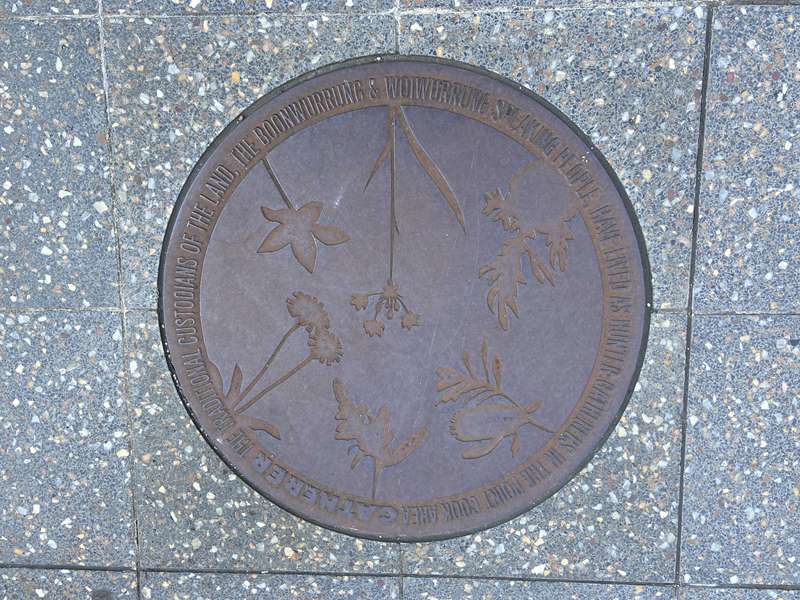
Circular is a series of eight cast-iron works installed along the footpath of Main Street, Point Cook. Quietly integrated into the streetscape, the works playfully take the familiar form of manhole covers while referencing the stories, values and diversity of the Point Cook area. Research for the Circular project involved listening, preserving and communicating people's stories. It also includes returning these stories to the community after the artwork is installed.
Location: Main Street, Point Cook.
Cypress by Ziggy Pawlikowski (2010)
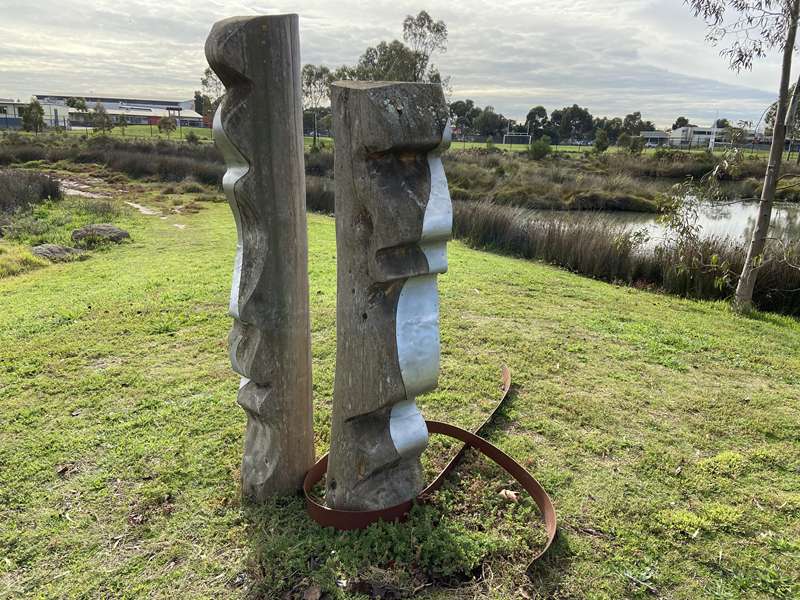
The wood utilizes Cypress timber that was felled in 2008. The artwork comprises of two Cypress timber logs and stainless steel inserts and is an abstract artwork that reflects the organic shapes of the wetlands.
Location: Hemsley Promenade opposite Toledo Crescent, Point Cook.
Frog Dreaming by Maree Clarke, Vicki Couzens and Jeph Neale (2011)
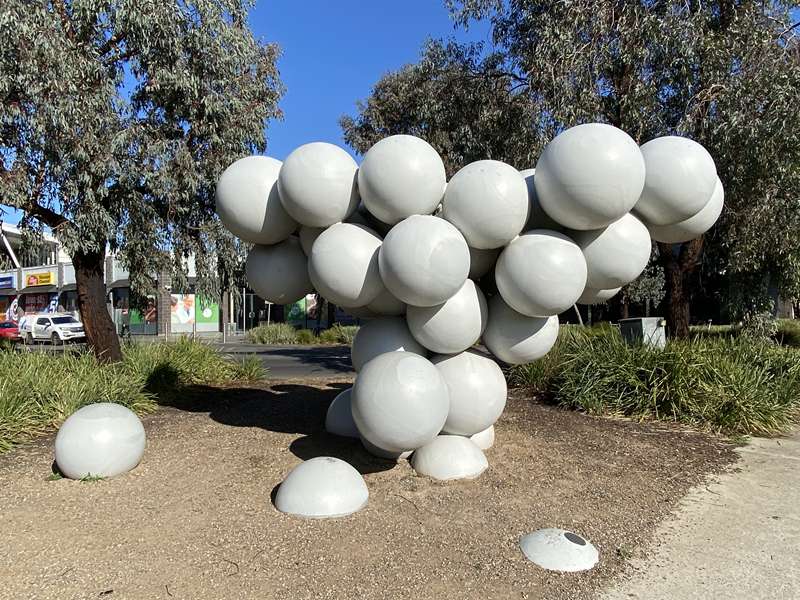
Frog Dreaming is a large scale sculptural is an abstract representation of a mass of frog eggs. The artwork is inspired by the Growling Grass Frog, a species once common to the grasslands and wetlands of Point Cook, now endangered and threatened.
Location: Boardwalk Boulevard Wetlands, Main Street, Point Cook.
Hard Copy by Paul Johnson and Gail Mason (2009)
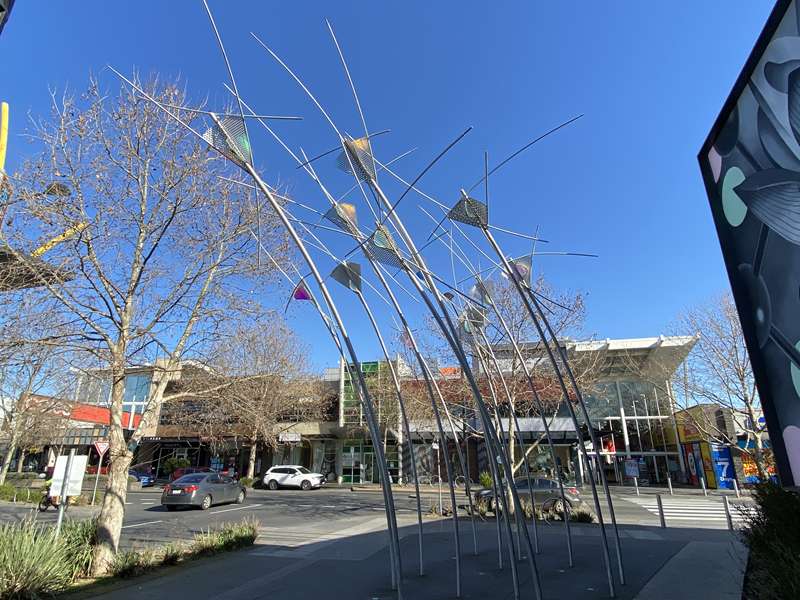
Location: Point Cook Community Learning Centre, 1 Cheetham Street, Point Cook.
Migration by Michael Peck
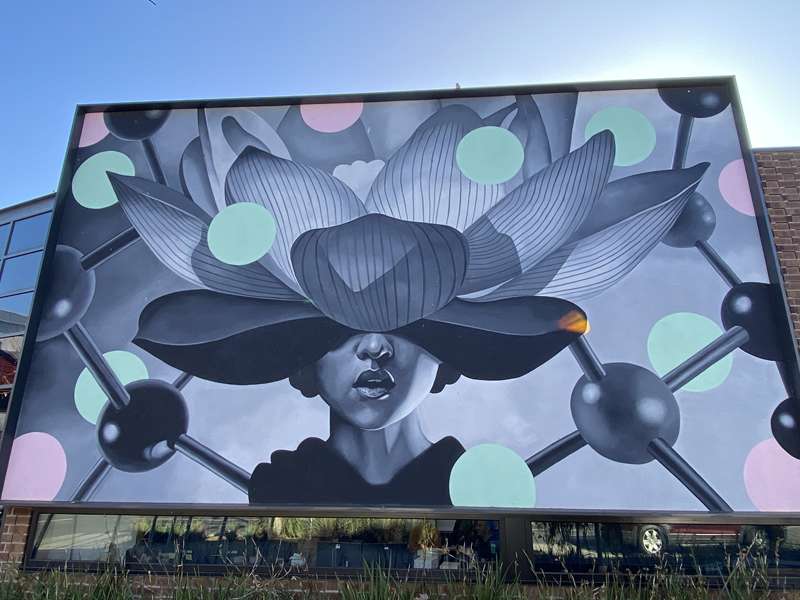
Migration is a three-piece public artwork which seeks to depict deep human connection and connection to nature as key characteristics of a contemporary and cosmopolitan community - like Point Cook.
The artwork was developed following conversations with the Point Cook community about their sense of place and what living in Point Cook means to them. What emerged from the conversation is that the cultural diversity of Point Cook, it?s early adoption of technology and the shore birds that populate the bay are iconic images - all of these are seen in the final artwork.
Michael says about this artwork: "Cheetham Wetlands provided significant inspiration for the three murals... and are a positive symbol for Point Cook and the community that flourishes there. The central motif of the mural is the lotus, although not a native flora to Point Cook, it is a wetlands flower that is traditionally meaningful in many cultures as a symbol of personal growth, representing the overcoming of adversity; it alludes to the story of many people who have come to call Point Cook home, planting their roots and thriving in the new environment. The resulting images advocate the positive and interconnected cultural identity that has begun to form within Point Cook; one of freedom, self discovery and a promising future."
Location: Point Cook Library, 1 Cheetham Street, Point Cook.
Tahitian Terrace Sculpture
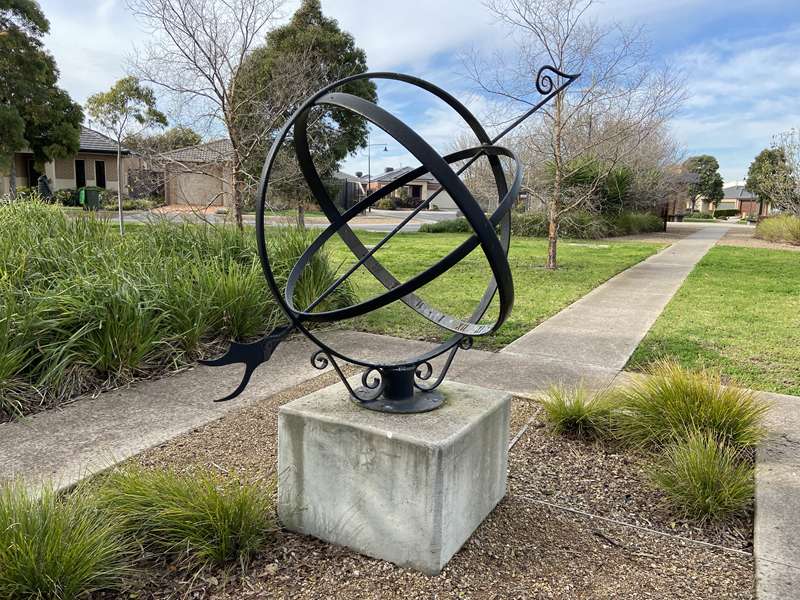
Location: 3 Tahitian Terrace, Point Cook
Alamanda Wetlands Sea Eagle Sculptures
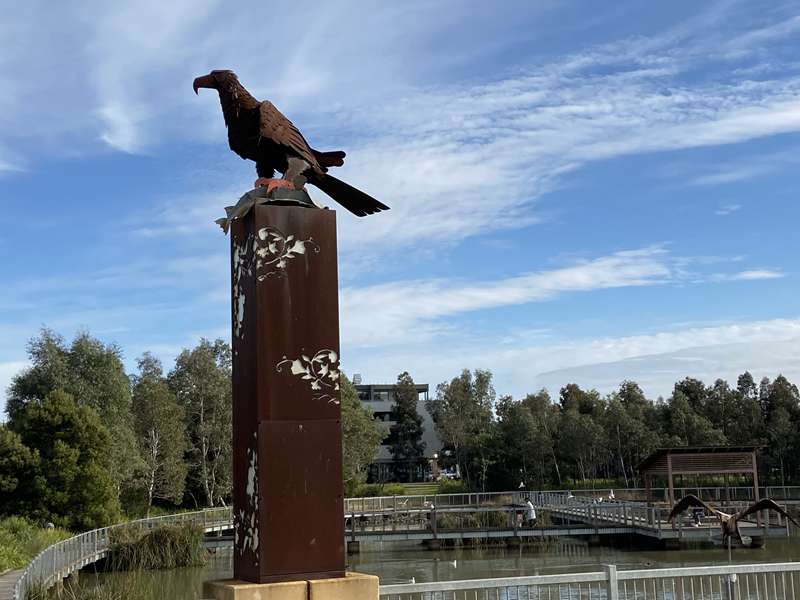
Location: 11 Paradise Parade, Point Cook
Finch Electrical Box Mural by Soleveins
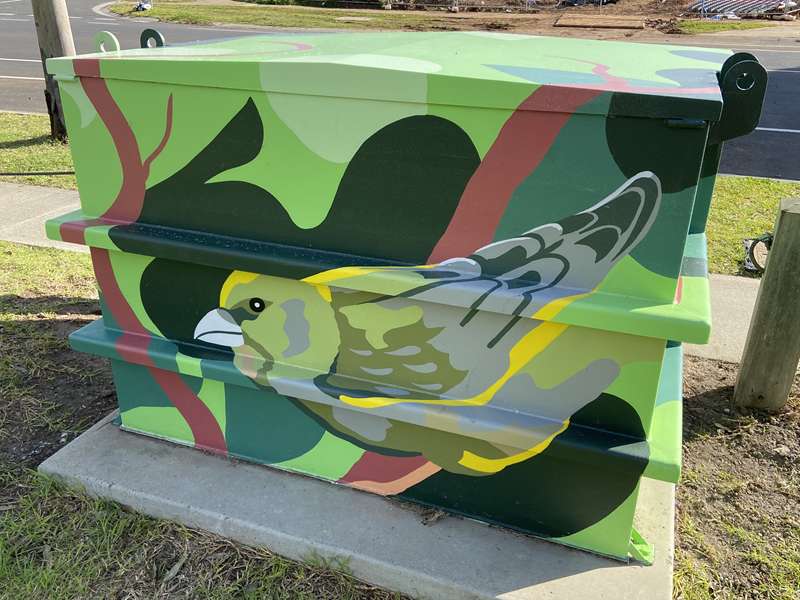
Location: Bayview Park, 45 Alamanda Boulevard, Point Cook
Sulphur-crested Cockatoos Electrical Box Mural by David Lee Pereira
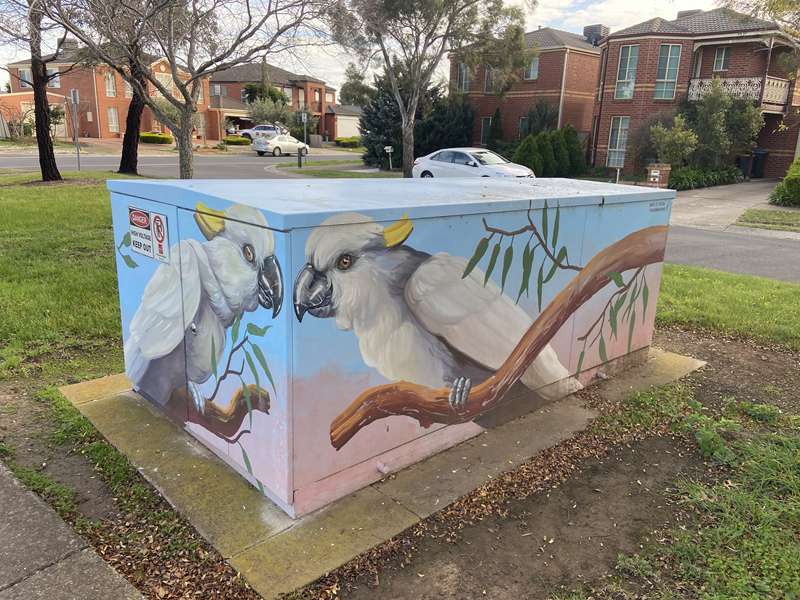
Location: Willowgreen Way Reserve, 5 The Avenue, Point Cook
Navigation by Fonofale McCarthy (2015)
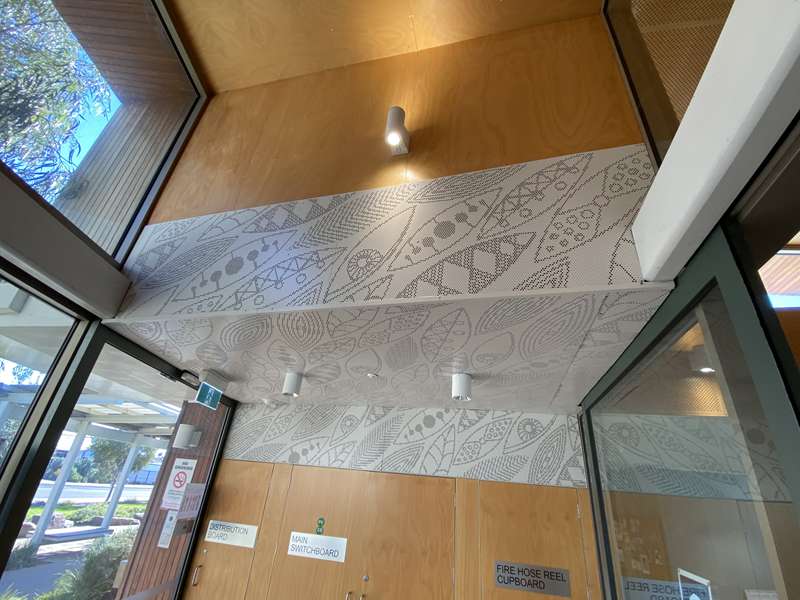
This artwork was inspired by the natural environment, the surrounding landscape of Saltwater and its local community. Through a process of community engagement with the local residents (through several local community based workshops), people were given the opportunity to share what is important to them and freely expressed their ideas, identity, culture, traditions, hobbies, goals and aspirations.
Each panel presents its own unique design to represent life in the community, navigating through the diverse ethnicities that shape and share the environment, fostering unification and respect for one another.
The artwork is positioned in the main entrance to usher visitors into a place of refuge from the world, a place they call home, a place with a sense of belonging and ownership. It plays homage to the individual, people and family; referencing their life experience, journey, relocation, migration, movement and collectively embracing this new community and adopted land.
Location: Saltwater Community Centre, 153 Saltwater Promenade, Point Cook.
Not So Silent Witnesses (Wetlands) by Rosa Tato (2015)
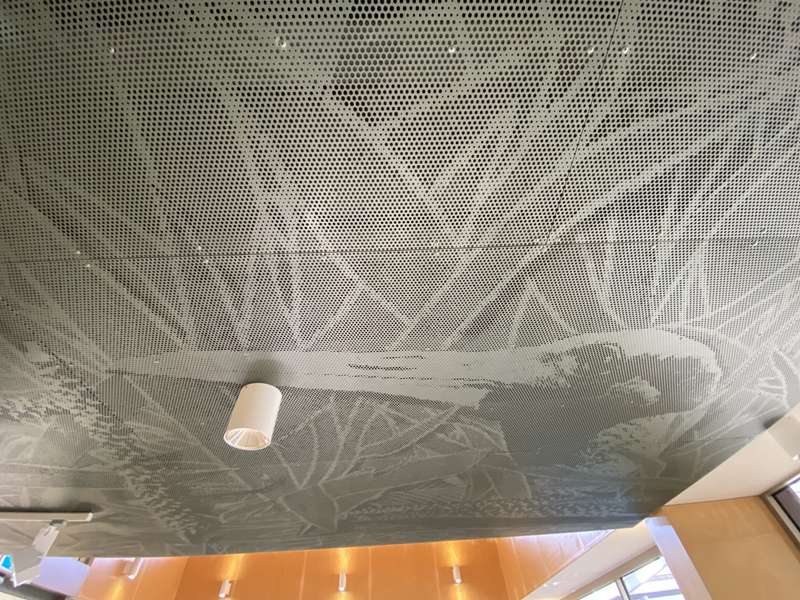
Rosa is interested in the viewer's discovery and the bird's resilience in an ever changing environment. Cheetham Wetlands, Point Cook are a world-renowned wildlife haven. This migratory birdlife sanctuary is both beautiful and ever changing. The birds chosen in this artwork design can be seen at these local wetlands; many of them rare and endangered species. The interrelationship between the natural and the man made was Rosa's impetus to discovery. Rosa wanted to focus on the fundamental importance of the 'current statuses' of these bird species. Can find the Spoonbill, Bellied Parrot, Pelican or the Brolgas?
Location: Saltwater Community Centre, 153 Saltwater Promenade, Point Cook.
Ripple by Louise Lavarack (2015)
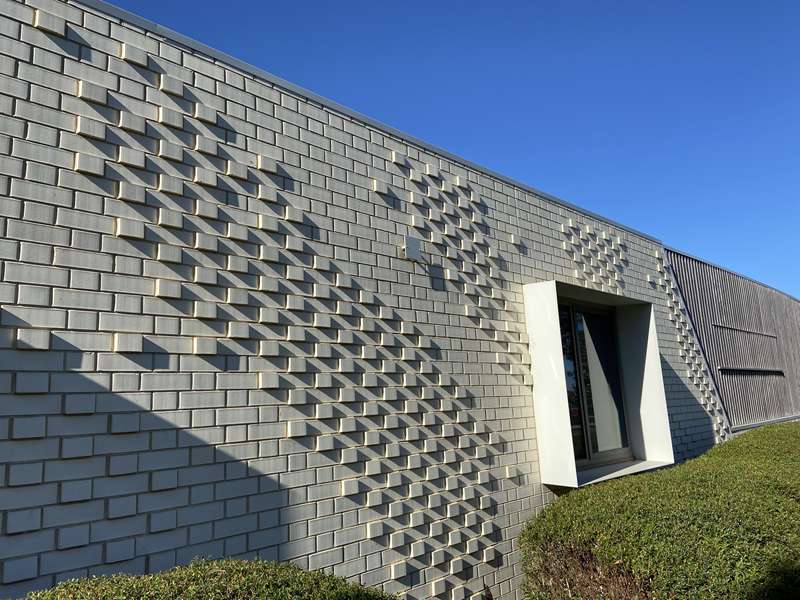
The creamy white walls of the new Saltwater Community Centre evoke the local landscape. They undulate around the architectural spaces of the building, like wind-sifted sand slipping through dune grasses. The brickwork that forms these walls is articulated further in a series of meandering 'bitmapped' ripples that morph along the surface. This treatment is inspired by the big skies and sweeping cloudscapes that cast sun and rippling shadow across the landscape of Point Cook, and by the breeze-ruffled waters of coastal wetlands.
Location: Saltwater Community Centre, 153 Saltwater Promenade, Point Cook.
Symbiosis by Matthew Harding (2004)
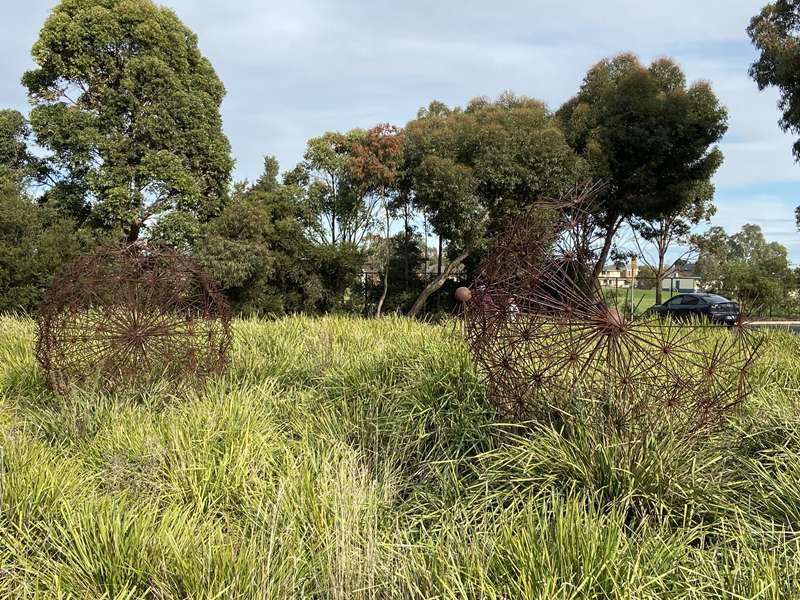
"This work continues my investigations into the geometrics and structure of natural forms and acts, reminding me of the child like fascination that must have inspired great mathematicians, engineers and philosophers. Euclid's elements of geometry, Archimedes spiral, Fibonacci's sequence and Buckminster Fuller's geodesic domes and testament of the spirit to understand and consciously belong to this world.
A symbiotic relationship exists between the fragile form of a dandelion and the ecology of our planet. Plants through photosynthesis convert solar energy into the basic foodstuff that the whole life cycle of earth ultimately depends upon. Our understanding of our position on the food chain is crucial to our survival as a species. We are not immune to extinction.
There is a spatial relationship between the three seed forms which allude to their transient nature within the landscape, emphasised through their varying states of dispersion. Airborne, these seeds carry the latent potential for new life or may also act as an affirmation of hope for our future by attaching credence to the childhood game of blowing wishes." - the late Matthew Harding
Location: Jamieson Way Community Centre, 59 Jamieson Way, Point Cook.
Target Point Cook Mural
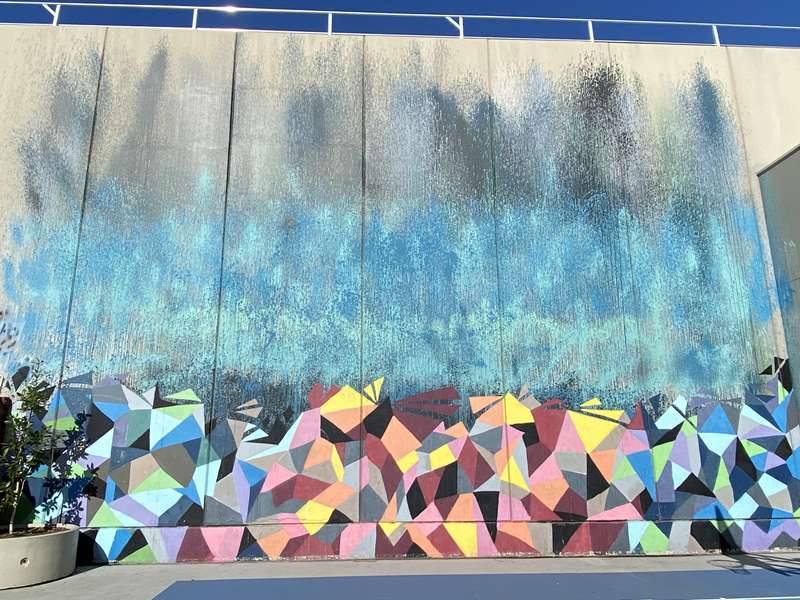
Location: Outside Target, Murnong Street, Point Cook
Jamieson Way Community Centre Carpark Electrical Box Mural by David Lee Pereira
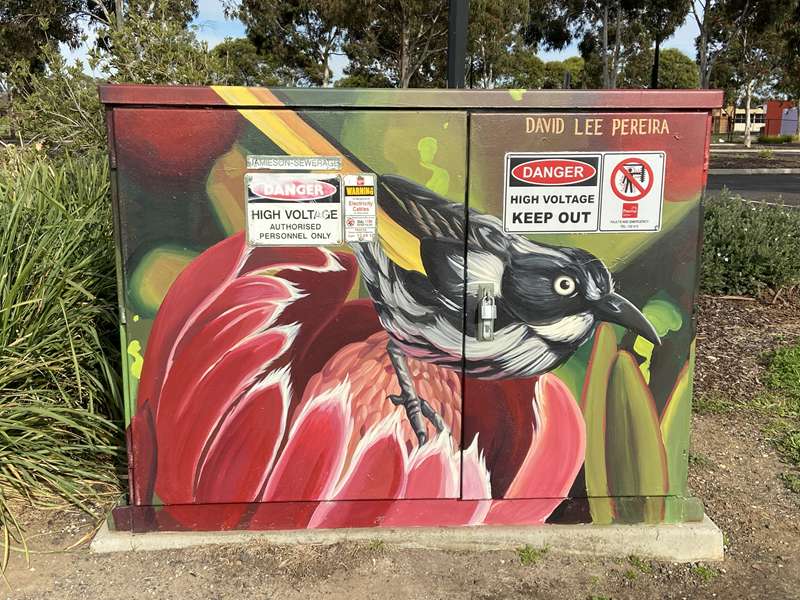
Location: Jamieson Way Community Centre, 59 Jamieson Way, Point Cook
Jamieson Way Community Centre Carpark Electrical Box Mural by David Lee Pereira
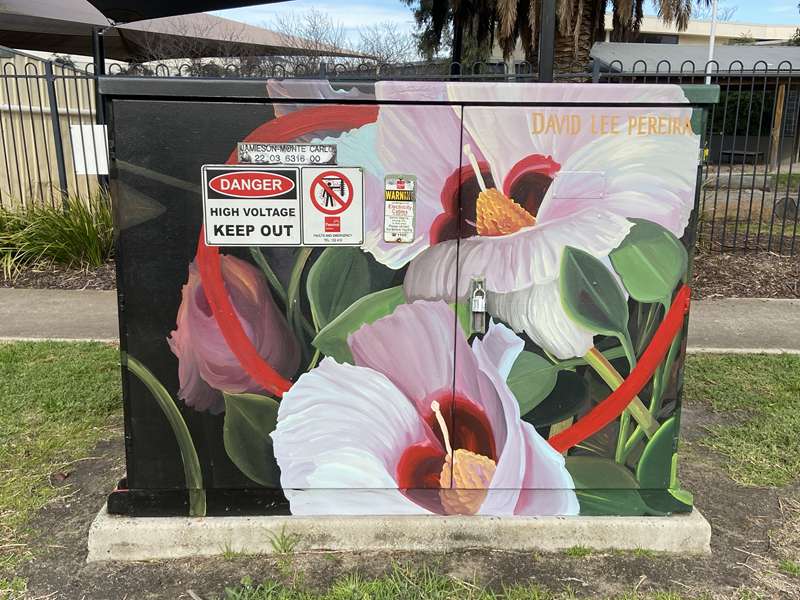
Location: Jamieson Way Community Centre, 59 Jamieson Way, Point Cook
Brolga and Floral Mural by Bryan Itch
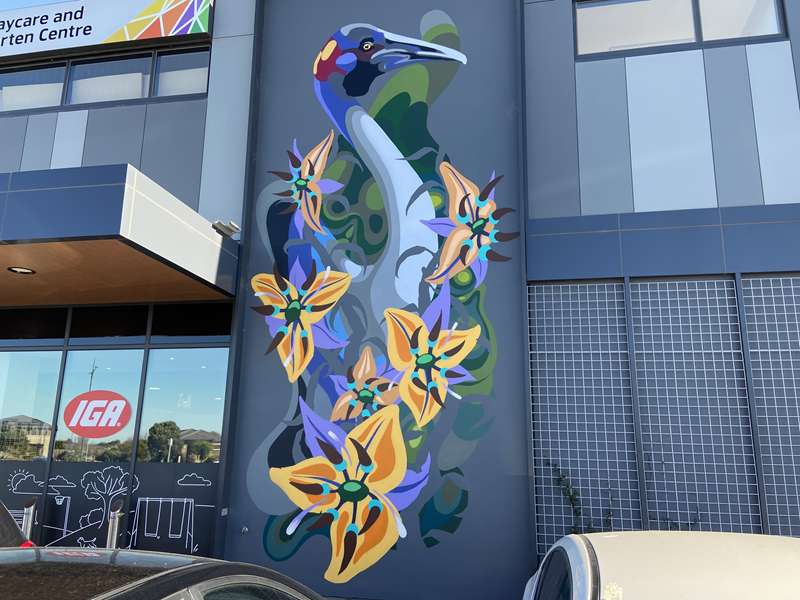
Location: IGA, 165 Saltwater Promenade, Point Cook
Point Cook Coastal Park Murals by Lara Secondary College students
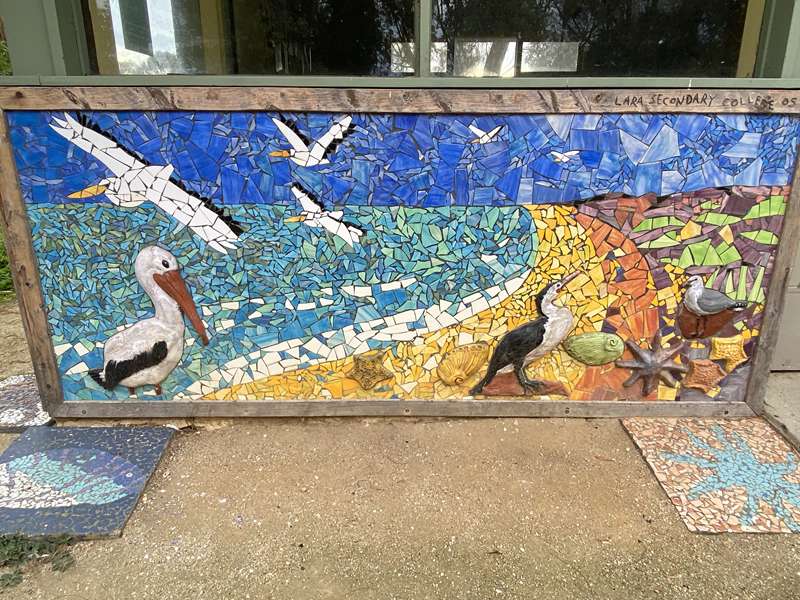
Location: Point Cook Coastal Park, Point Cook Road, Point Cook.
Tarneit Area:
Fossil by Kirsteen Pieterse (2008)
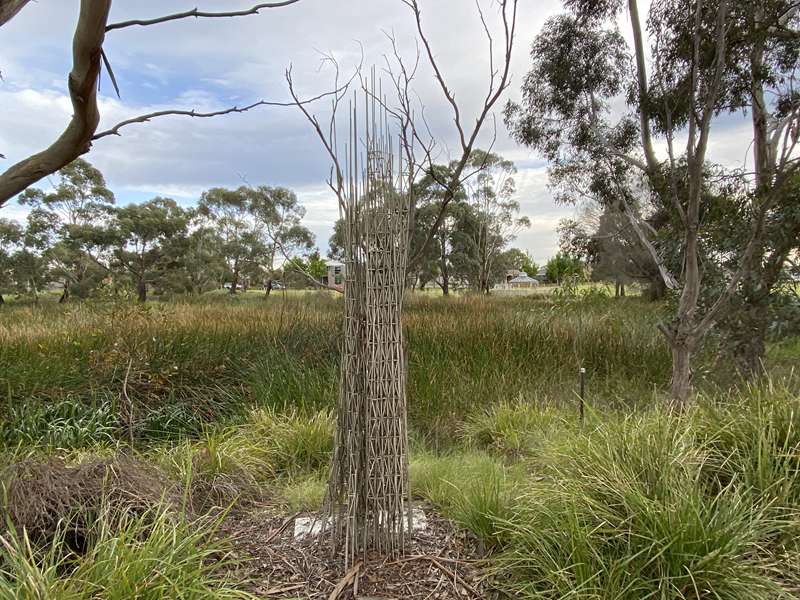
Location: By the creek on Thomas Carr Drive, Tarneit.
Sun Dial
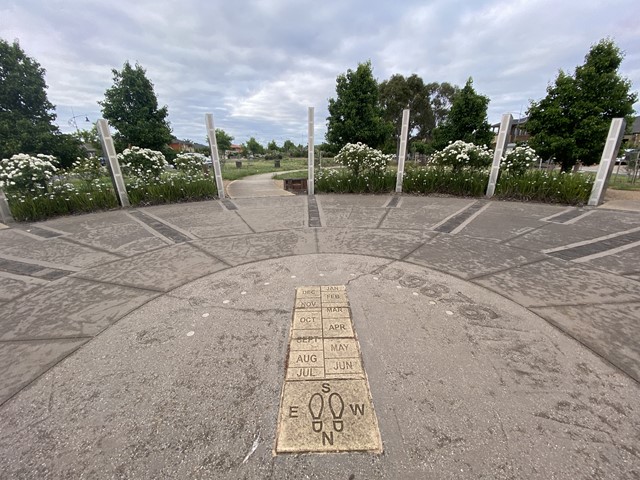
The Sun Dial is an interactive time piece, stand in the right position to cast your shadow and tell the time. At night the Sun Dial bursts into light as a prominent sculpture of the estate.
Location: Cnr Sundial Boulevard and Serenity Way, Tarneit.
Possum on Electrical Box by David Lee Pereira
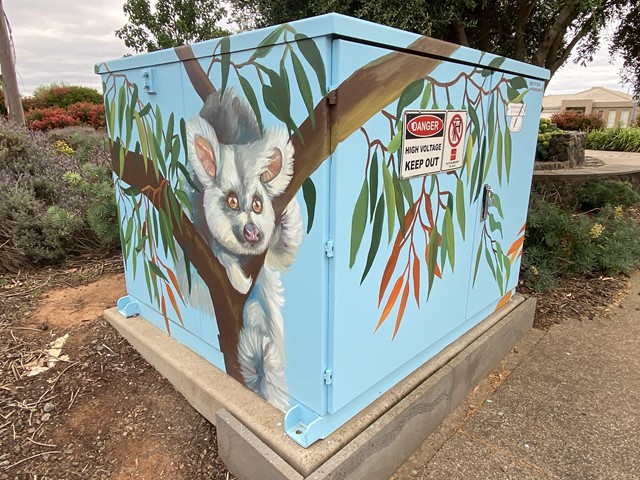
Location: Cnr Serenity Way and Rainbow Way, Tarneit
New Holland Honeyeater on Electrical Box by David Lee Pereira
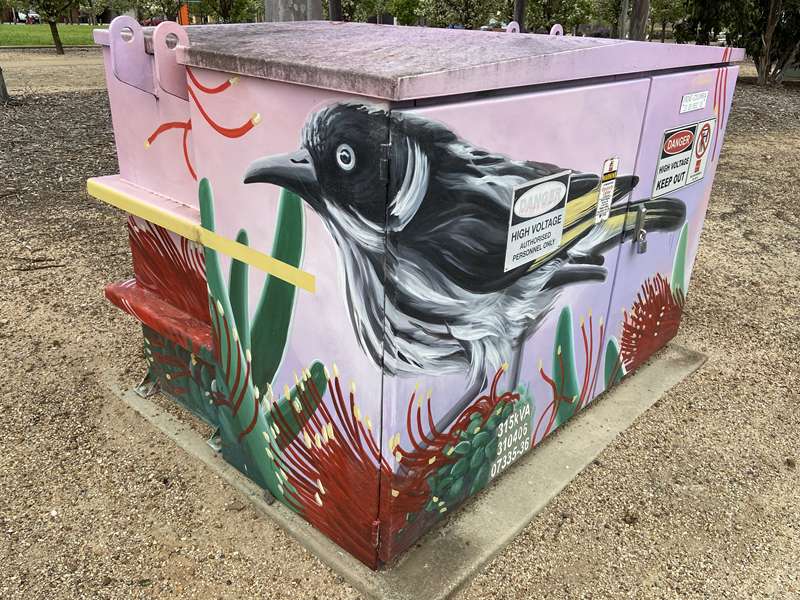
Location: 7 Grove Street, Tarneit
Light Poles in the Seasons Estate
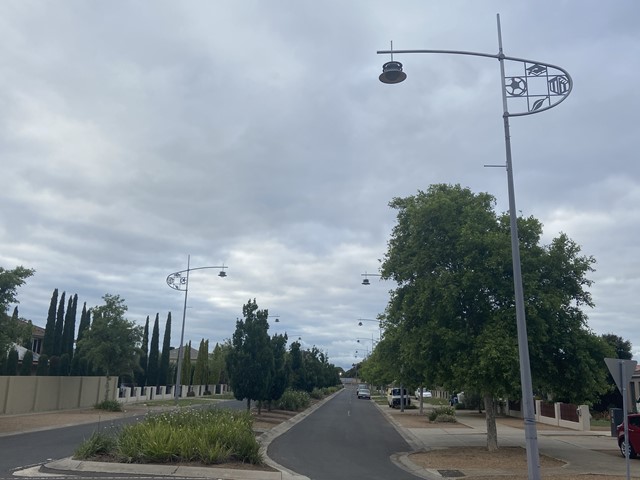
Location: Along Seasons Boulevard (and around surrounding streets), Tarneit.
River Red Gum Leaf Seats
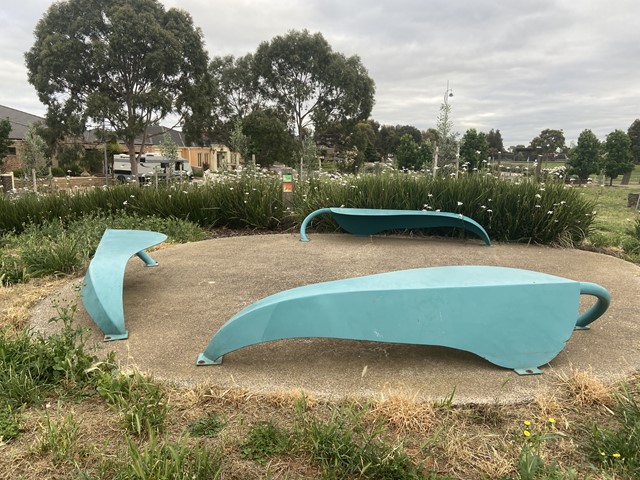
The seats are in the shape of the River Red Gum leaf, a majestic tree found along the waterways of the Wyndam district, some isolated copses can still be found in the area.
Location: Serenity Way Park, Serenity Way, Tarneit.
Wedge Tail Eagle
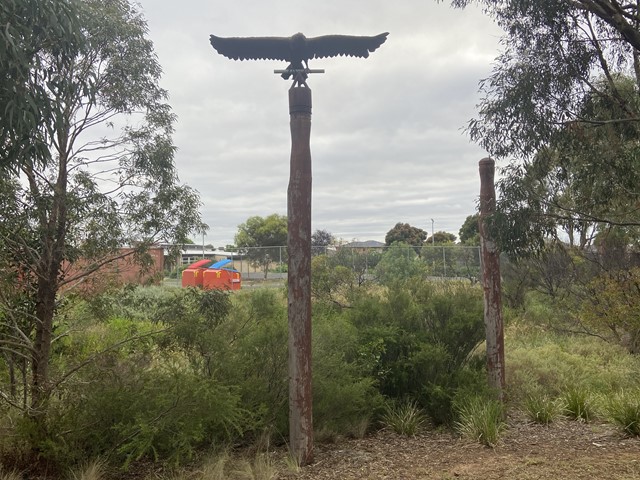
The Wedge Tail Eagle used to be a majestic sight, soaring high above the dry plains of Werribee and surrounding districts, nesting in the tall eucalyptus. Keep an eye out! They might still be around.
Location: 2 Equinox Close, Tarneit (next to Tarneit Creek)
Tree and Flowers Electrical Box Mural by David Lee Pereira
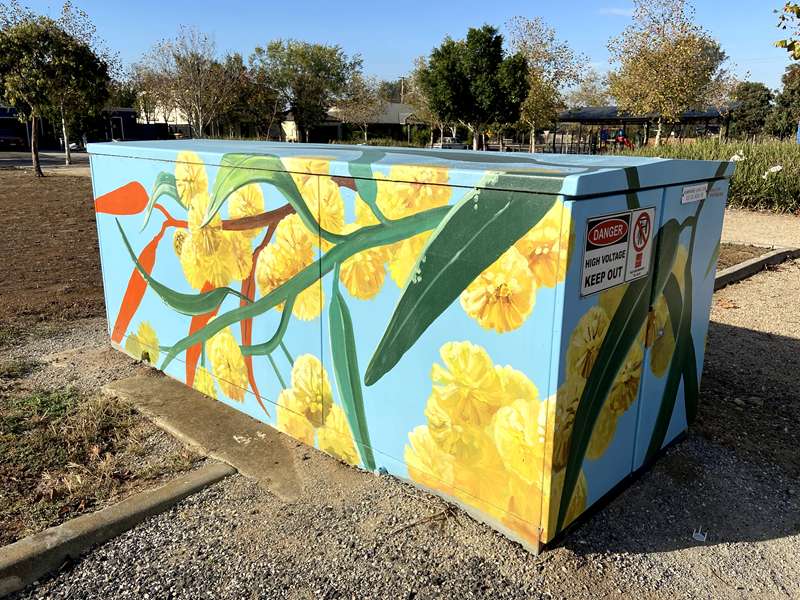
Location: 11A Hampshire Court, Tarneit
Leaves and Flowers Electrical Box Mural
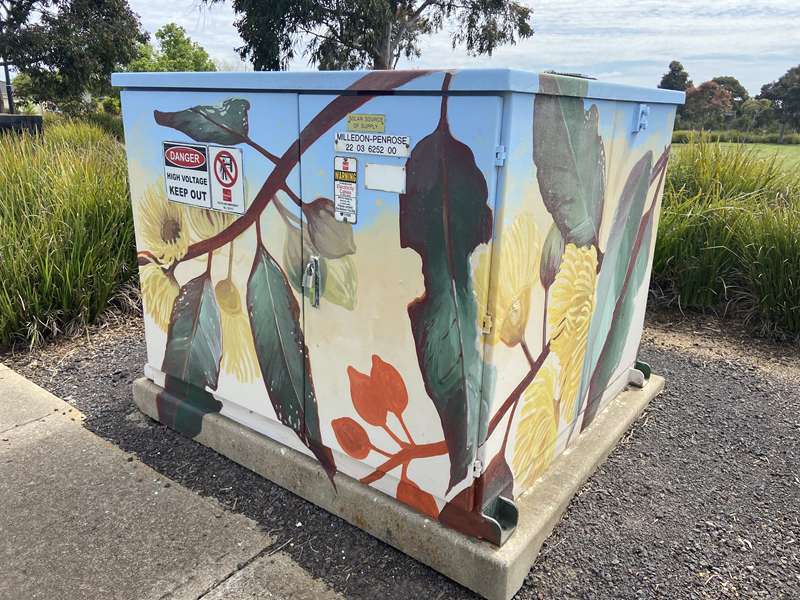
Location: 19 Millendon Boulevard, Tarneit
Orange-bellied Parrot Electrical Box Mural by David Lee Pereira
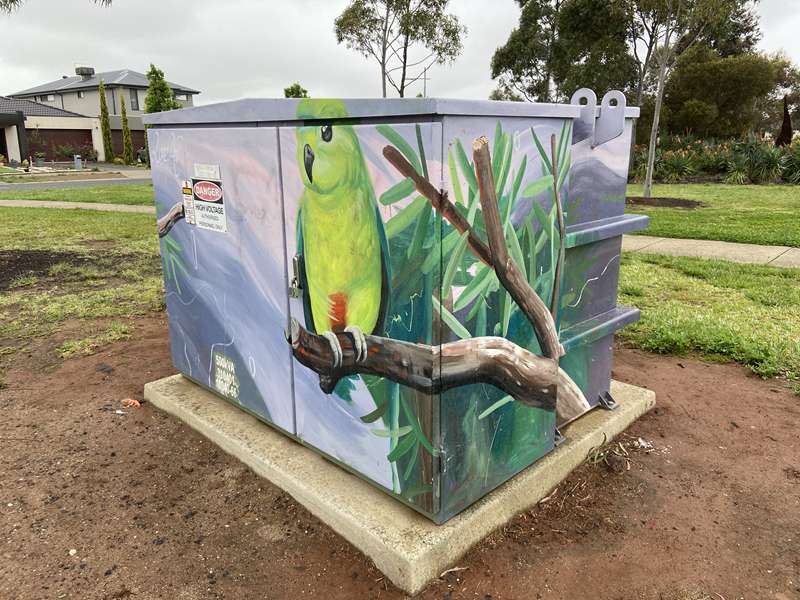
Location: 14 Yanga Avenue, Tarneit
Gang-gang Cockatoo Electrical Box Mural
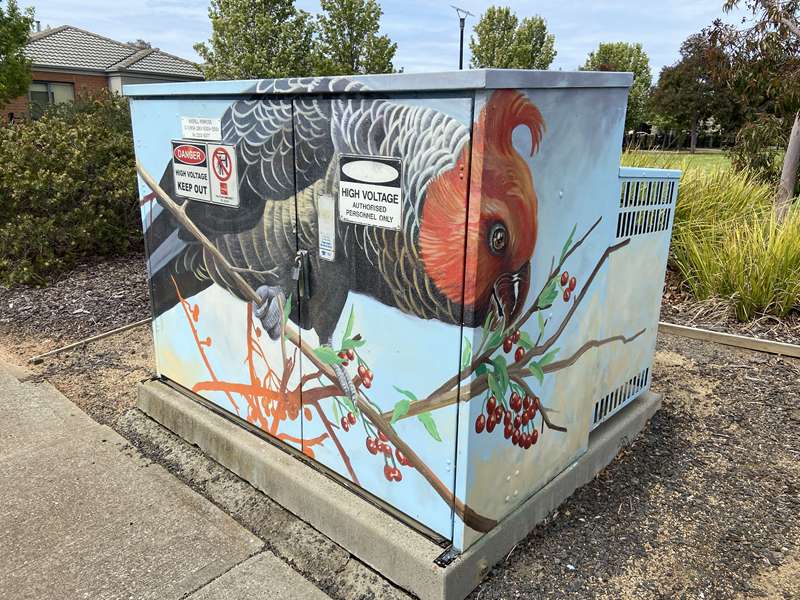
Location: Opposite 13 Inverell Parkway, Tarneit
Mother Tongue by Vicki Couzens (2022)
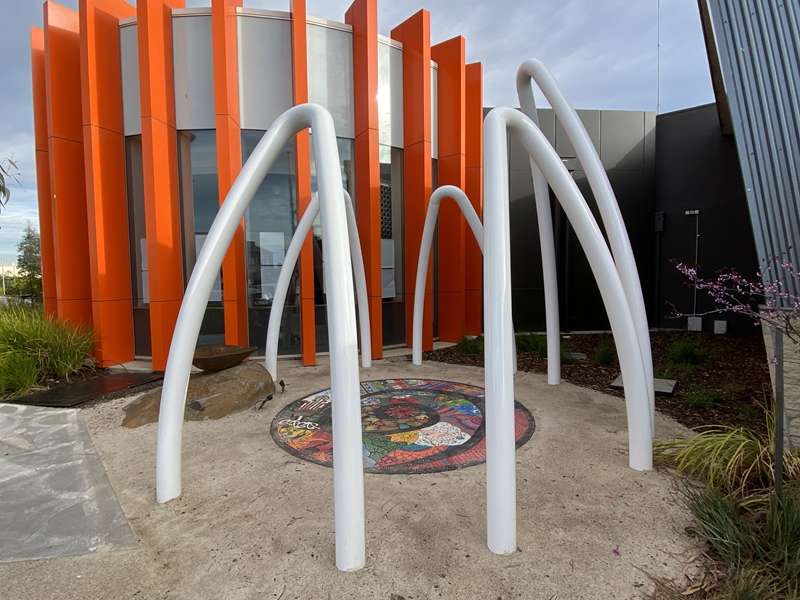
'Voice of the Land, Voice of the People, Voice of our Heart, Voice of Mother - Mother Tongue' - Dr Vicki Couzens
Collaborating with local multicultural artists from the Bunurong, African Diaspora, Bangla, Chin, Karen, Karenni, Maori, Indian and Sikh communities, Couzens worked to incorporate key visual elements from each culture into the final artwork. It acknowledges the importance of mother language in the strengthening of individual and community identity and culture.
Location: Tarneit Community Learning Centre (outside), 150 Sunset Views Boulevard, Tarneit
Tarneit Community Learning Centre Mural
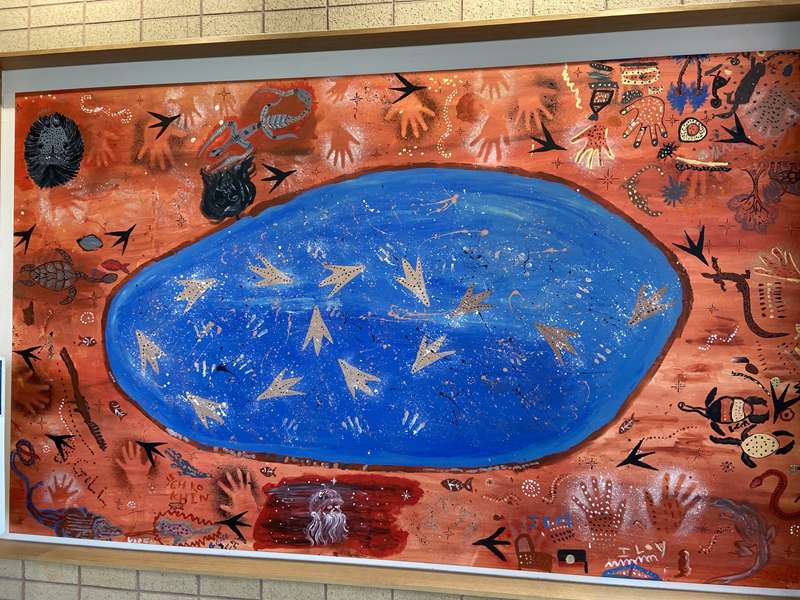
Location: Tarneit Community Learning Centre (inside), 150 Sunset Views Boulevard, Tarneit
Water Fountain Artwork
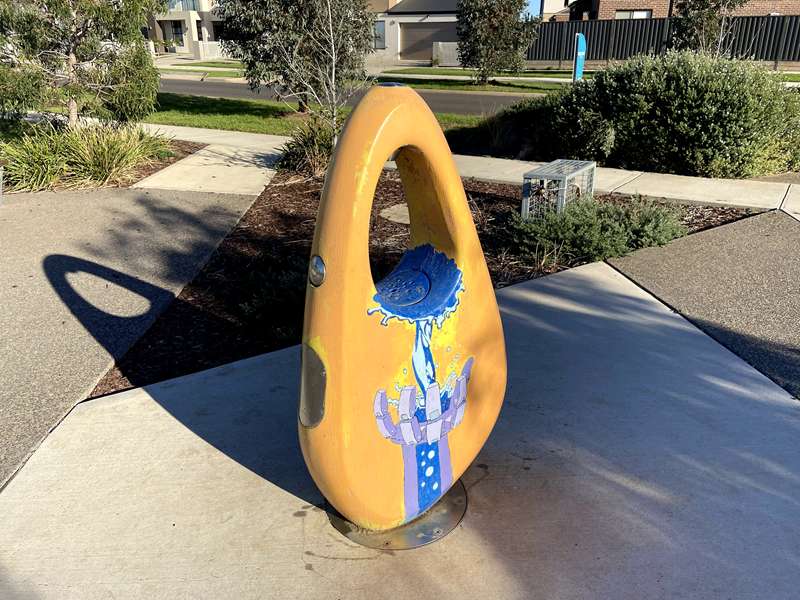
Location: Cnr Chianti Ridge and Hermosa Drive, Tarneit
Rocket Sculpture
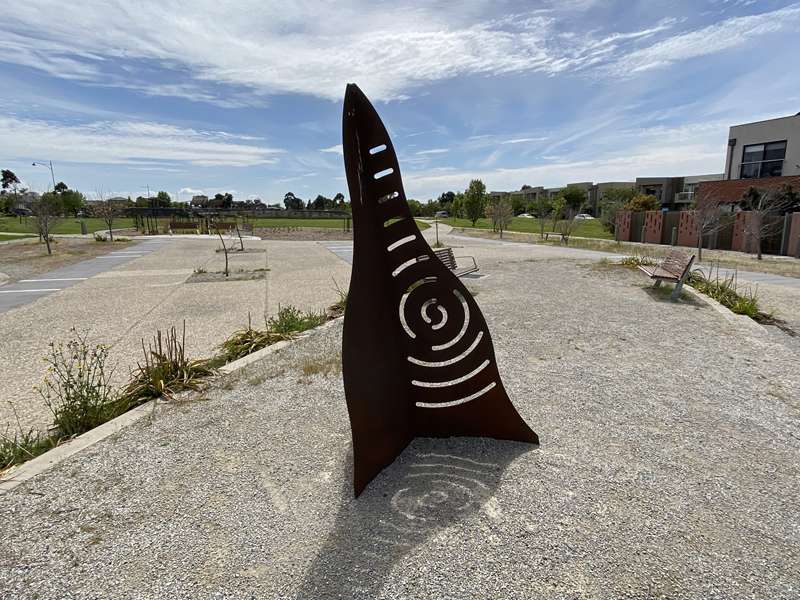
Location: 103 Inverell Parkway, Tarneit
Rocket Sculpture
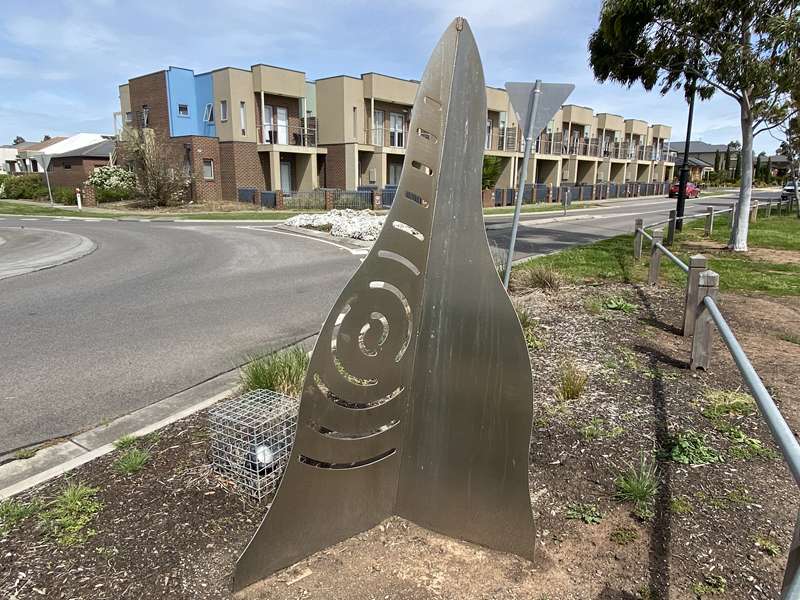
Location: 103 Inverell Parkway, Tarneit
Kookaburras in Tree Sculpture
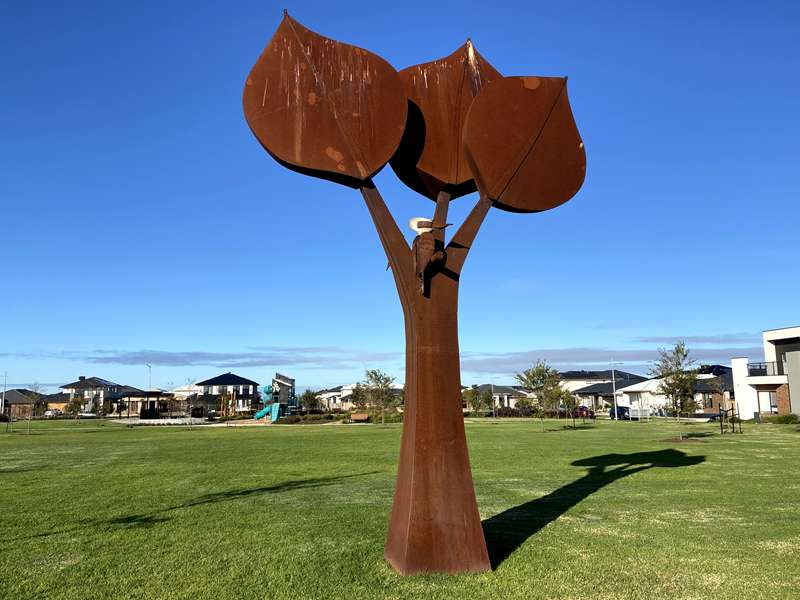
Location: Cnr Rippleside Terrace and Reflections Boulevard, Tarneit
Morris Road Underpass Mural
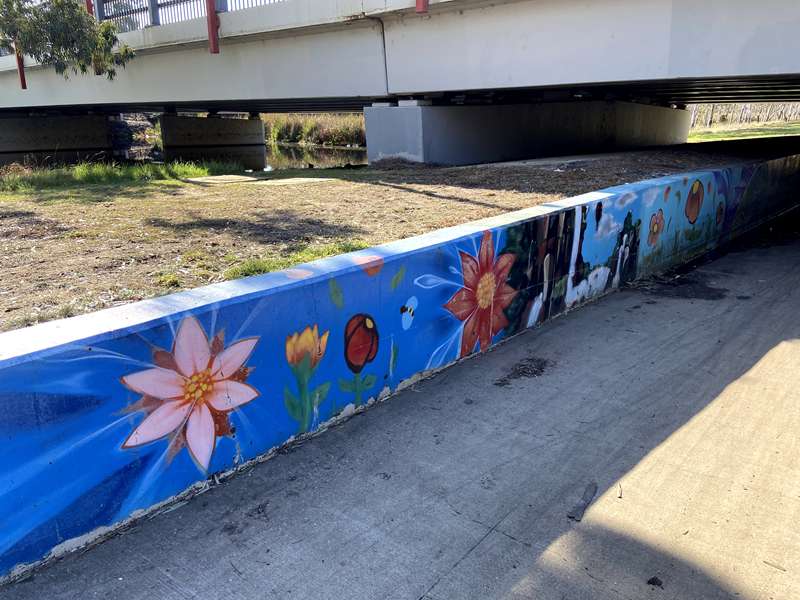
Location: 433A Morris Road, Tarneit
Truganina Area:
Indoor/ Outdoor by Elaine Miles (2012)
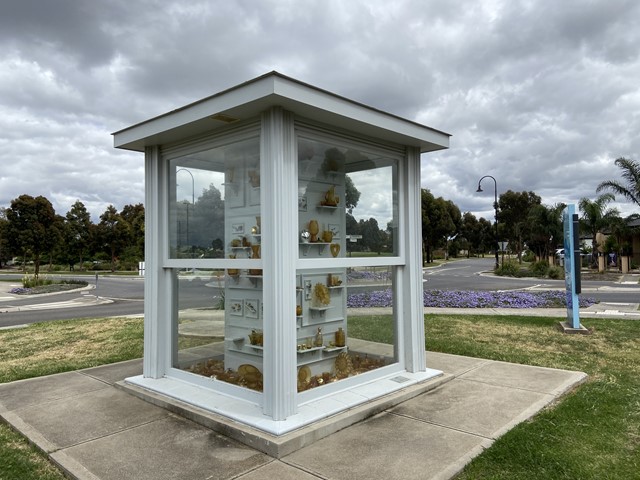
Stylised display cabinet housing personal objects and mementos.
"The collection of amber and gold glass objects that lay within the cabinet, were compiled together with local community groups that frequent the Arndell Park Community Centre. These 'readymade' items were chosen to evoke thoughts of home, and assist to promote the benefits of recycling and sustainable practices in today's environment. Many of these objects were donated and contributed by Wyndham residents and or purchased from the local charity stores." - Elaine Miles
Location: Arndell Park Community Centre (outside near carpark entrance), 29-49 Federation Boulevard, Truganina.
Arndell Park Community Centre Carpark Electrical Box Mural
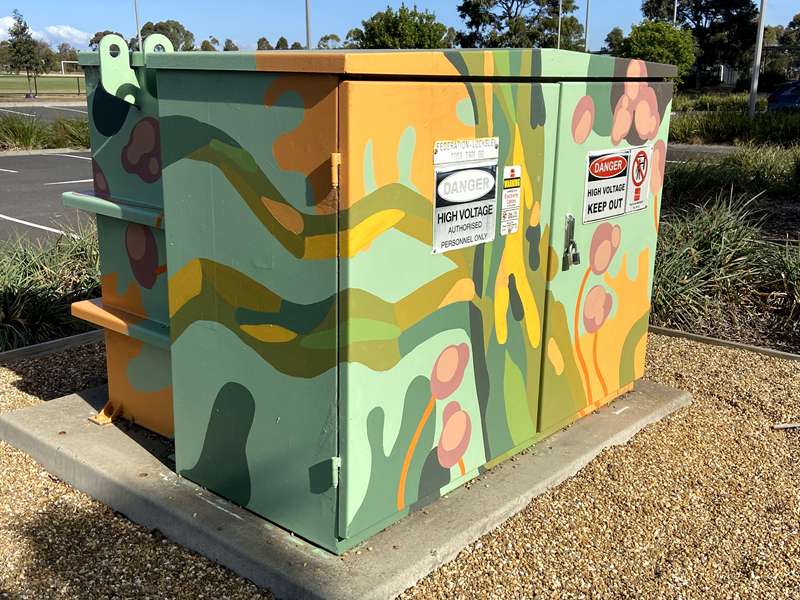
Location: Arndell Park Community Centre (near carpark entrance), 29-49 Federation Boulevard, Truganina.
Parkvista Drive Electrical Box Mural
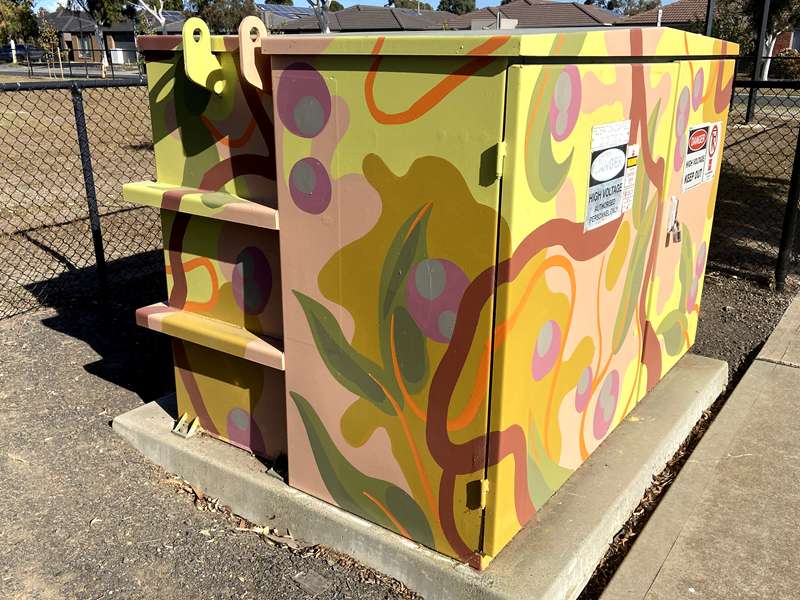
Location: 3 Parkvista Drive, Truganina
Willy Wagtails Electrical Box Mural
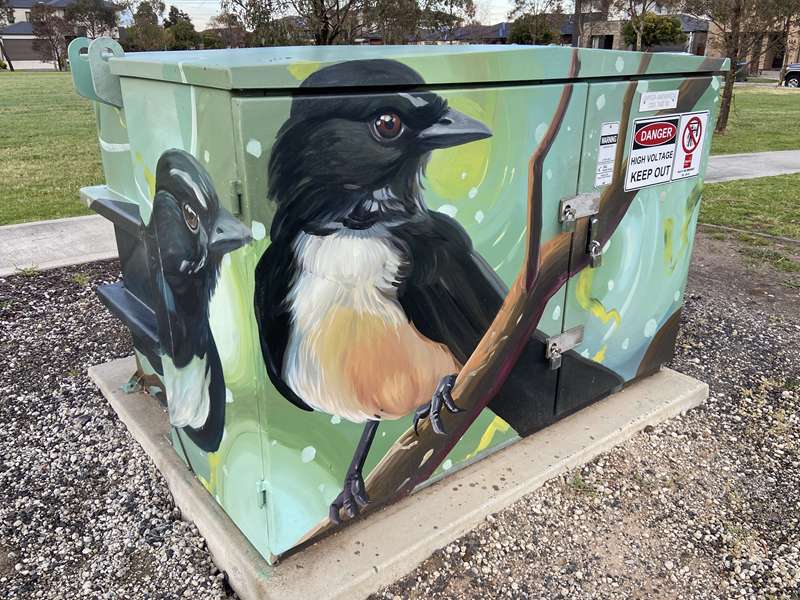
Location: 14 Jupiter Drive, Truganina
Australian Magpies Electrical Box Mural by David Lee Pereira
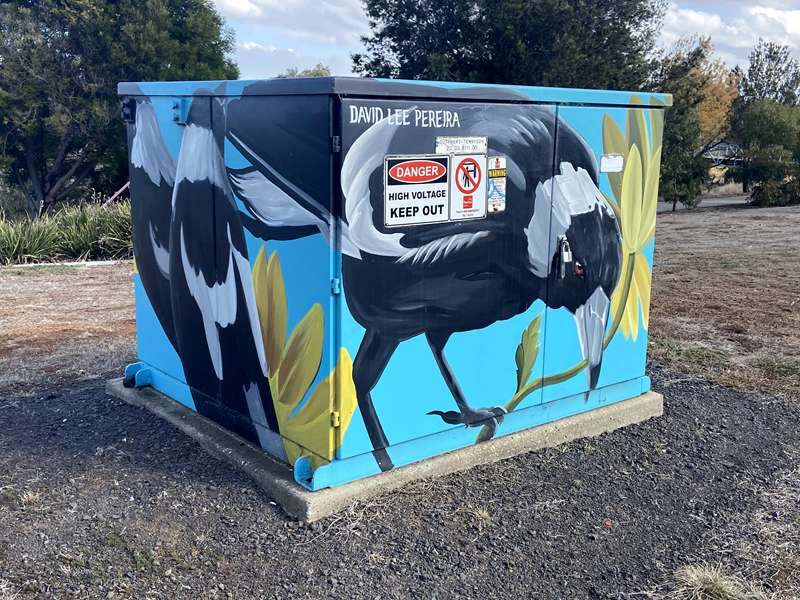
Location: 2 Cuthbert Avenue, Truganina
Werribee Area:
Werribee Water Tank Art by Hayden Dewar
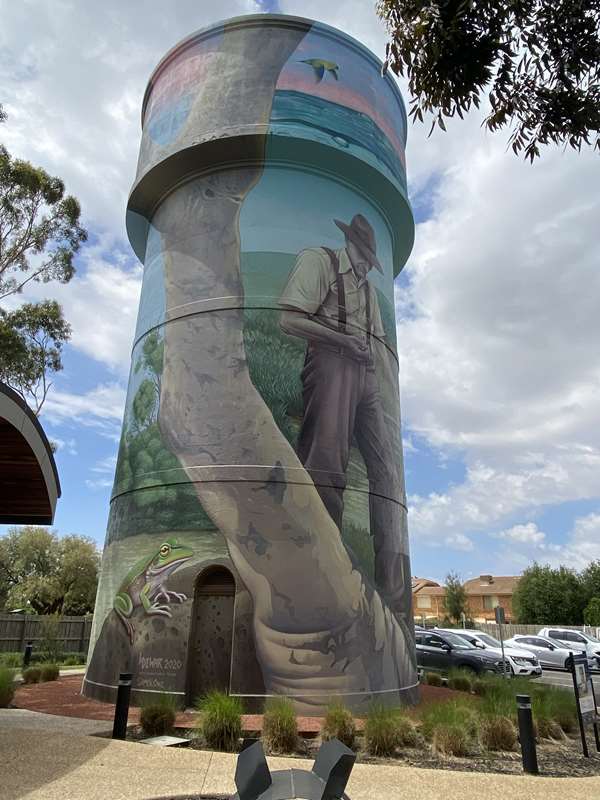
The concrete water tower was built by the State Rivers and Water Supply Commission in 1914 to create sufficient water pressure for distribution throughout the Werribee township. Water was pumped up into the Tower from an adjacent settling basin, which was in turn supplied from the Werribee Diversion Weir and channel from the Werribee River.
The channel is still in use as part of the irrigation supply to the Werribee South market gardens. The tower was decommissioned when Werribee was connected to Melbourne's water supply system in the late 1960s.
The mural design acknowledges the significance of the water tower in the development of Werribee, the waterways and the importance of agriculture in the area. The centre piece of the mural is a representation of a water bailiff checking the speed of a Dethridge Wheel, which measures the flow of water delivered to farms for irrigation, depicted by the market garden crop scene.
Locally significant flora and fauna also feature in the mural, including River Red gum trees which are commonly found along the Werribee River, a platypus, a Growling Grass Frog and Orange-bellied Parrots.
Location: 3 Tower Road, Werribee
Aquatic Nature Themed Mural
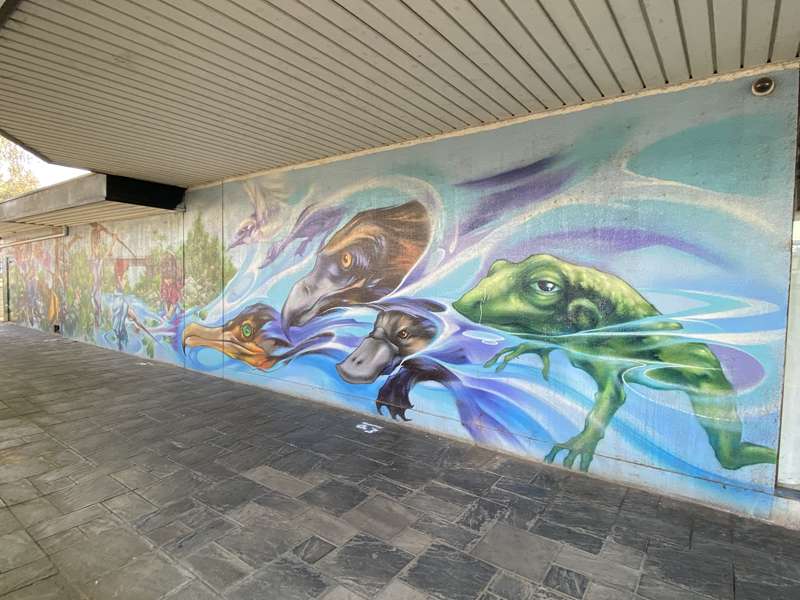
Location: 2 Station Place, Werribee.
Does it have to be so... 'Queer?' Mural by David Lee Pereira (2022)
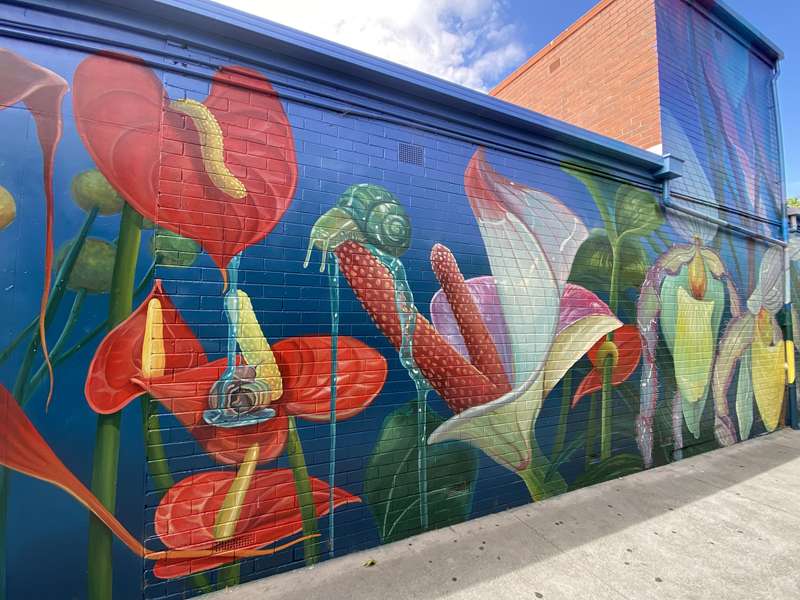
The huge vibrant and colourful mural has the concept of flowers fusing local flora and fauna and was designed to reflect the diverse and culturally rich background of the people of Wyndham. The flowers were also intended to subtly reflect themes of accepting gender and sexual diversity. These themes, however, were represented more strongly in the delivered artwork than had been intended and the council made some changes to the mural to address the "adult themes and community concern".
Location: 20 Station Place, Werribee
Mooroop Yarkeen (Spirit Dreaming) Mural by Tommy Day aka Jirii Jirri
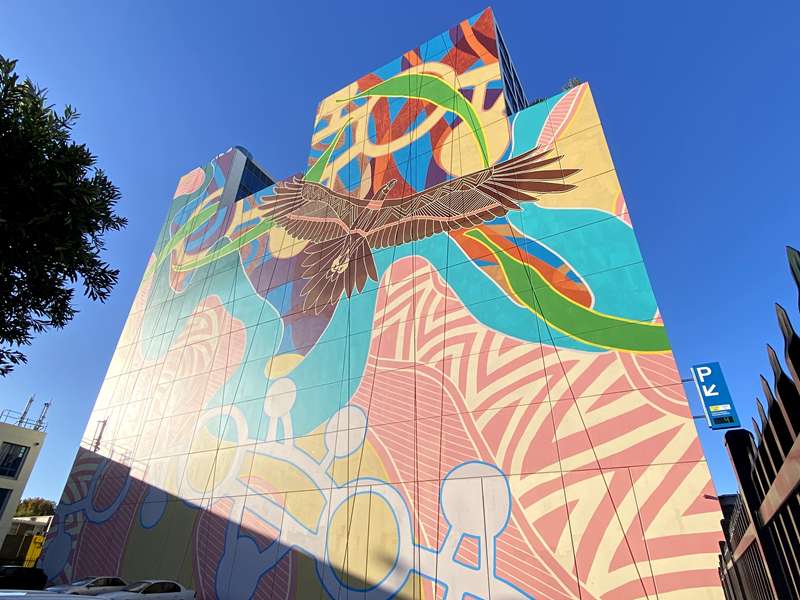
Award-winning First Nations 41m high mural. "The mural is vibrant, vivid, rich in texture and references to the Wirribi Yaluk (Werribee River), sandhills and Basalt plains, welcoming gum leaves, community coming together in unity, dreaming, and Bunjil?s flight." - Tommy Day
Location: Hunter Building, 22 Synnot Street, Werribee
Back To The River #1 by John Irving, Pamela Irving, Bernice White (1996)
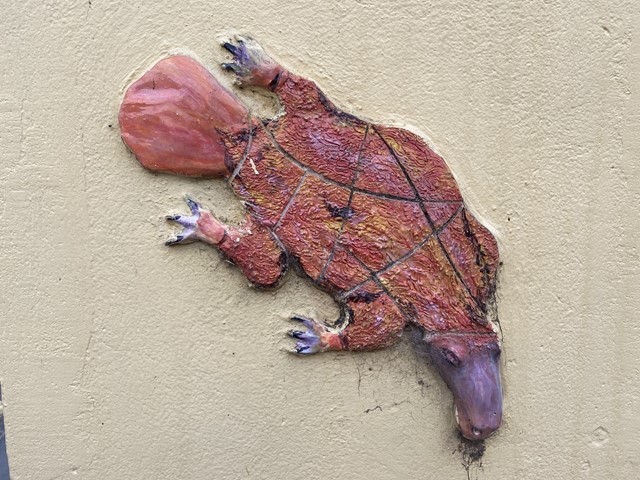
Ceramic creatures on the entrance gate to Chirnside Park.
Location: Chirnside Park, Cnr Watton Street and Werribee Street, Werribee.
Boulders Float After Years of Erosion by Rodney Payne (2002)

Following the path leading from the playground to the parks interior, three installations will be discovered. The first installation of three sculptures is at the small footbridge; the main installation flanks the path on arrival at the lake. Another installation of four sculptures can be found across the lake.
Comprising eighteen sculptures in four sizes, with a maximum height of half a metre, the boulder-like sculptures feature abstracted imagery inspired by Wyndham's landscape, flora and fauna. A patina varying in colour from green to rusty red is a feature of the work.
The work is designed to draw visitors further into the expansive park and to create a sense of wonder and surprise, especially for the young.
Location: Presidents Park, Heaths Road, Werribee
Kawirr yaneekan-werreeyt-a: Place of Emu Restings by Vicki Couzens with Jackman and Neale
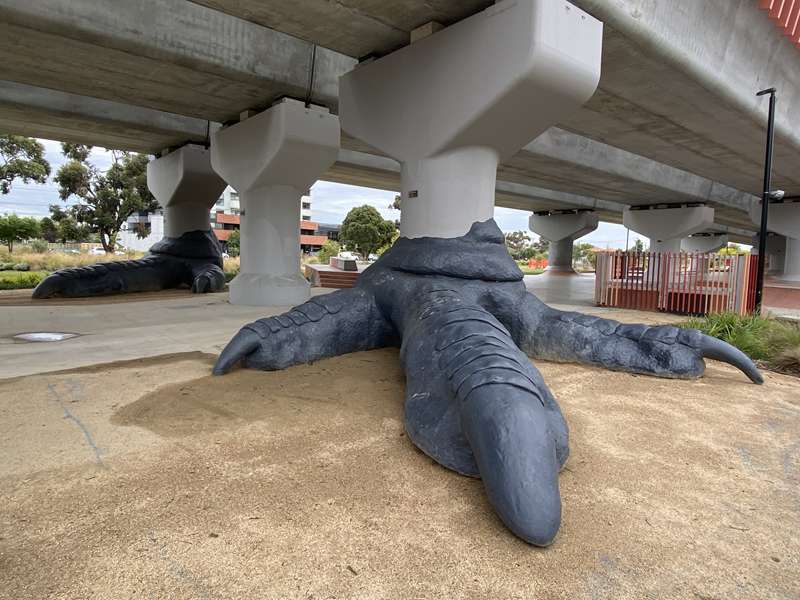
Location: Werribee Skatepark, 70 Cottrell Street, Werribee
Harpley Estate Sign
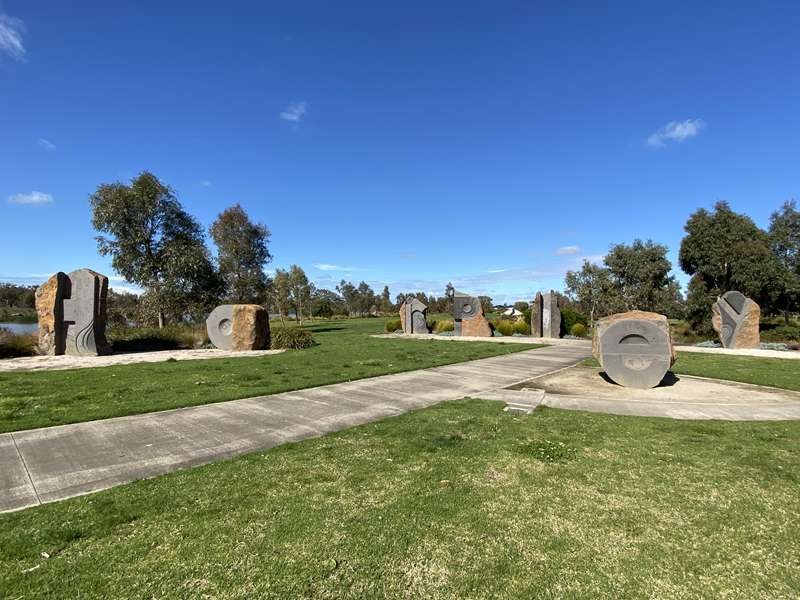
Location: Cnr Black Forest Road and Zircon Street, Werribee
CodeX by Karen Casey (2006)
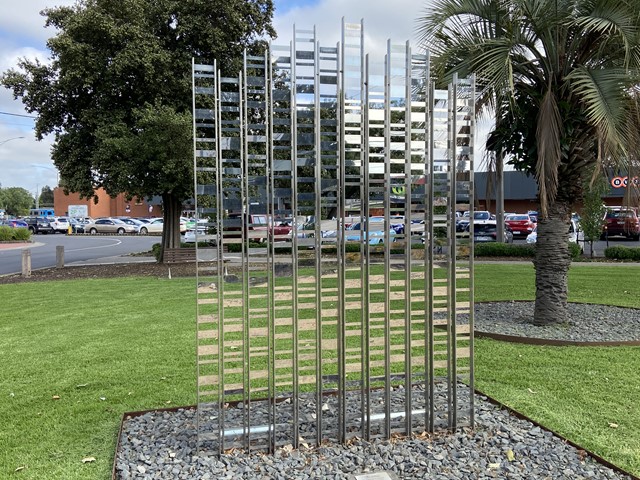
"Since our early ancestors first glimpsed their reflection in water the mirror has served as our most immediate means of personal identification. While our sense of self is intricately linked to our physical image, the discovery of DNA and subsequent mapping of the human genome has introduced a new mode of observation and level of perception, on the one hand acutely defining out personal differences, while at the same time extending our awareness beyond the bounds of individualism and enabling us to witness our undeniable bonds with the rest of the natural world" - Karen Casey
Location: Troupe Park, 1-9 Watton Street, Werribee
Finding the Forest Mural by Ghostpatrol (aka David Booth)
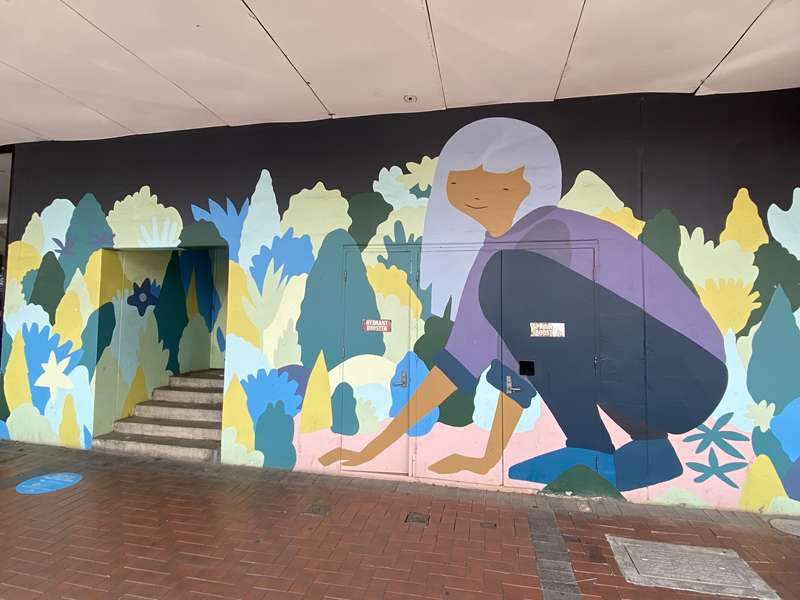
A playful piece that brings fun and a welcome touch of the greenery which references the You Yangs.
Location: Coles Wall, 133 Watton Street, Werribee
Constellation by Deborah Edwards (2008)
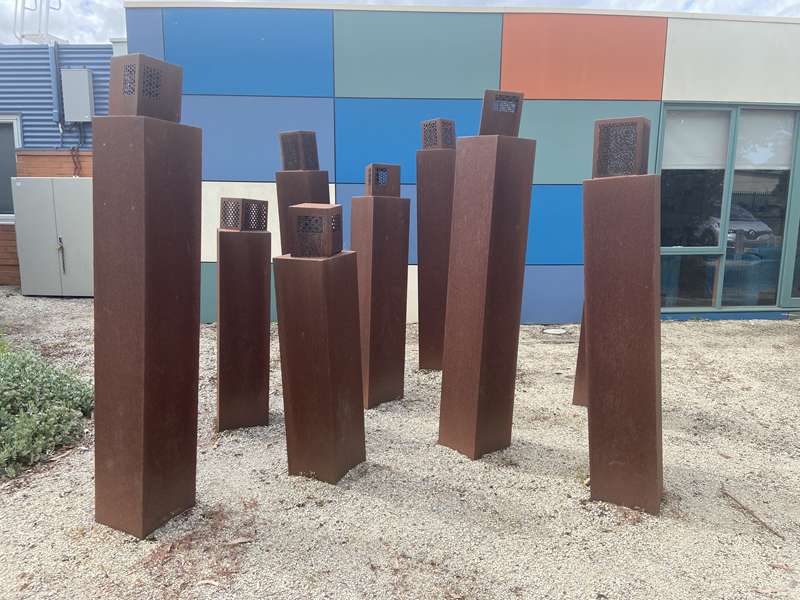
'Constellation' is an artwork that celebrates community, diversity and family. My aim was to assemble a bod of independent elements that were unique and could be related to in a series of body-like forms. Each element has its own point of difference in size, gesture and pattern. The integrity of the installation comes in to being when the individual elements come together to form a group. The configuration of the work is such that there is no beginning and end and the number of participants in the group is not exclusive. My main thought with this work was that it should convey openness and inclusion whilst maintaining the dignity of the individual." - Deborah Edwards
Location: Quantin Binnah Community Centre, 61 Thames Boulevard, Werribee
- Movement & Mirth by Minna Leunig
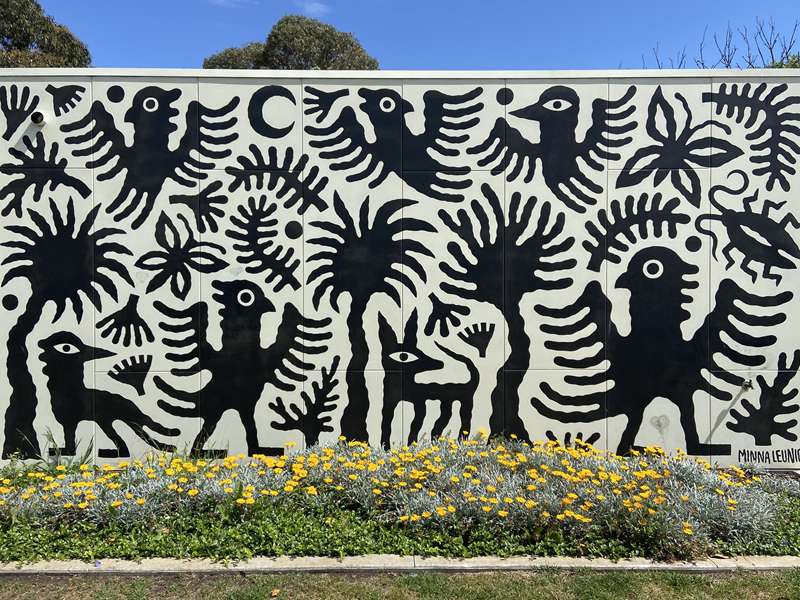
Murals on the Kelly Park toilet amenity block wall and table tennis table.
Location: Kelly Park, 2 Synnot Street, Werribee
Galvin Park Toilet Block Mural
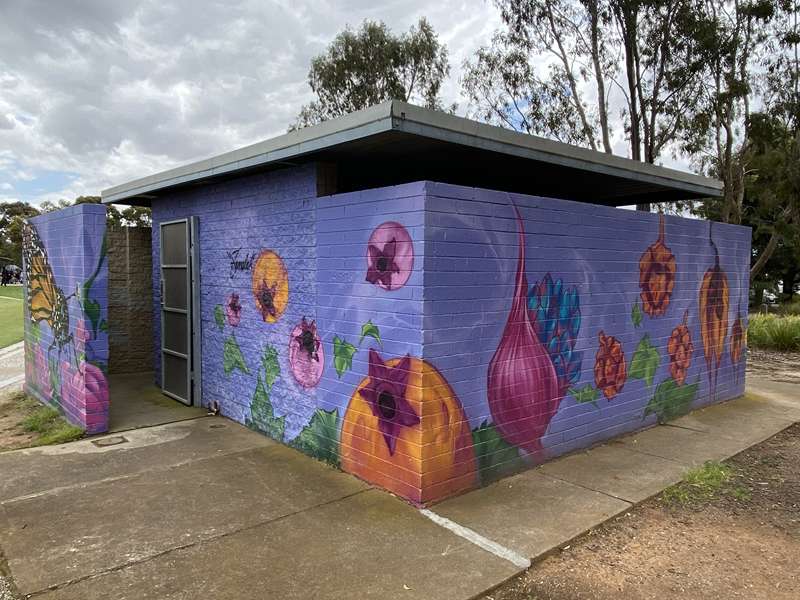
Location: Galvin Park, 84 Shaws Road, Werribee
Cultural River by Pam Stadus (2000)
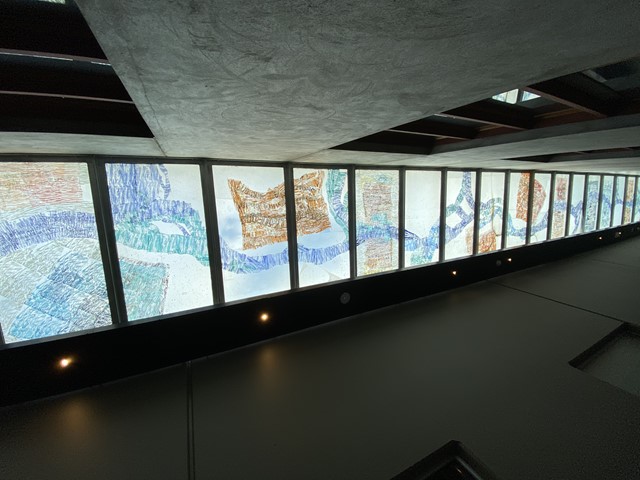
"A glass skylight, 30m long and 2m wide will tell a story about Wyndham, and how it evolved from a fertile natural habitat into an area supporting a present day community of many cultures, with distinctive visions for the future. The glass captures and reflects the shifting course of light as it travels through its daylight path and fills the interior space. Included within the glass are textures, maps, script, languages and photos definitive of the community groups involved in the project. Primarily the aim was to consider the past, present and future cultural changes and directions, and depict these within artwork". - Pam Stadus
Location: Wyndham Cultural Centre Roof Library entrance walkway, 177 Watton Street, Werribee.
Dancing Platypi by Anne Ross (2001)
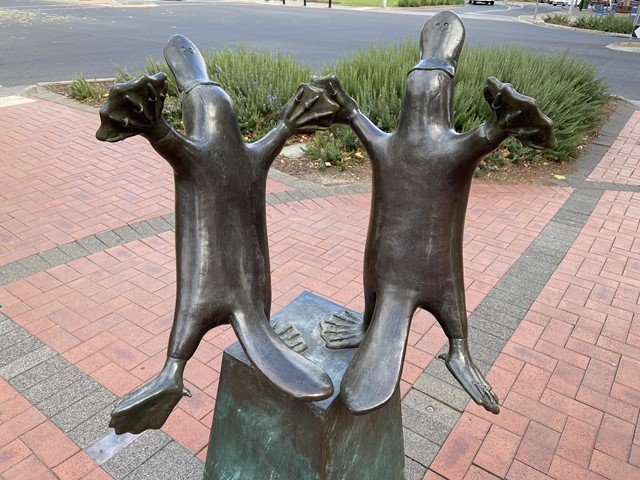
Part of a series of bronze works in various locations around Watton Street. Representing the natural wildlife of the Werribee River.
Location: Cnr Watton Street and Duncans Road, Werribee
Werribee Open Range Zoo Themed Mural by Mike Makatron, Chuck Mayfield and Nitsuta
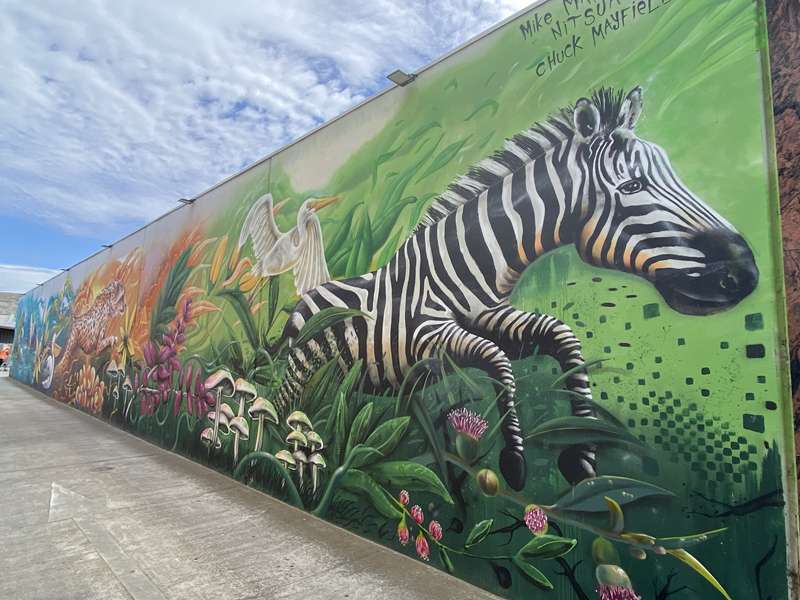
The mural was inspired by animals at Werribee Open Range Zoo and flora and fauna along the Werribee River.
Location: 10 Watton Street, Werribee
Accordion Player with Shoppers by Anne Ross (2001)
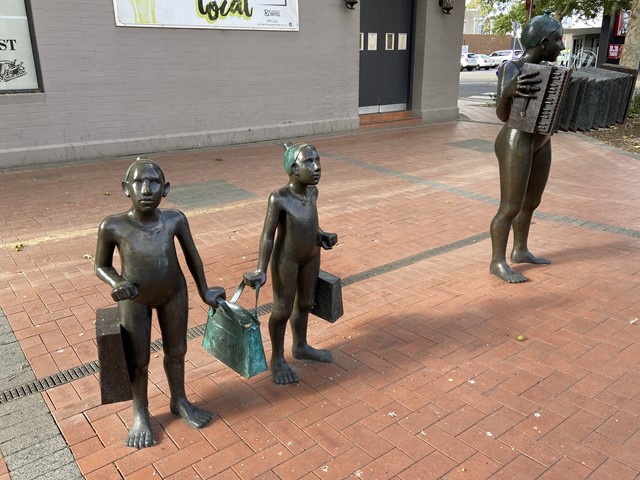
Part of a series of bronze works in various locations around Watton Street. These sculptures represent the city life of Wyndham, industry, businesses, shops and social activity - the heart of the CBD. The figure on the left looks back towards the dog and bird at the previous site, while the figure with the accordion looks forward towards the next site. The larger figure plays the accordion in celebration of the many immigrants from Southern Italy between the first and second world wars; who brought with them many varied skills and contributed considerably to the changing culture of Wyndham. The two smaller figures are holding bags between them, possibly alluding to days of old, when people carried produce home from the market gardens. Alternatively they may be contemporary shoppers, or one bag may be a briefcase, illustrating the business aspect of the CBD.
Location: Cnr Watton Street & Bridge Street, Werribee.
Jive by Grant Finck (2012)
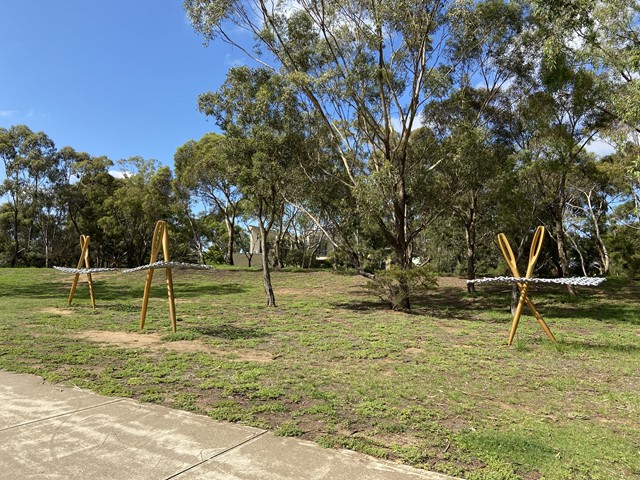
Three sets a giant sewing needles walk across the lawns surrounding Werribee River....
The artist, Grant Finck, has created an artwork inspired by the Werribee River and its surrounds, the sculpture encompassing different elements fused together to form an image representing the natural surroundings and their relationship to the human inhabitants - present, past and future. The sculpture consists of two main elements, stylized representations of sewing needles and woven mesh. The sewing needles also represent legs and appear to be walking. This implied forward movement in the sculpture represents progression. It reflects the action of people along the trail, the constant movements of animals, birds and insects, which inhabit the area as well as the river. The stylized form of the woven mesh symbolizes the fabric of time from the formation of the land and river to the present urban influence.
The strongly symbolic use of the sewing needles and mesh will invite different interpretations and is designed to inspire the viewer's imagination.
Location: Werribee River, near the end of Mambourin Street, Werribee.
Kirrip Wurrung Biik (Friend, Mouth, Country) by Mandy Nicholson (Wurundjeri artist) (2016)
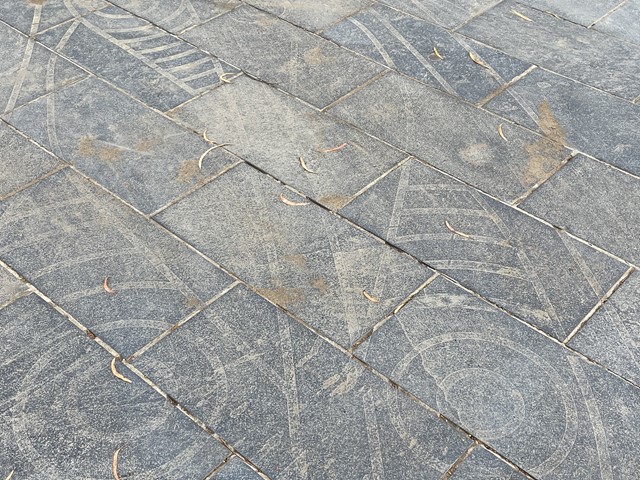
The artwork, in black limestone, brings recognition to Victorian rich, strong and proud Indigenous culture. It assists in the appreciation of some of the complexities of Indigenous Nations life including traditional trade routes, ceremonies, cultural heritage, languages and 'country'. This artwork is an acknowledgement of the Kulin Nation which consists of five separate clans of South Central Victoria, Watha wurrung, Dja Dja wurrung, Boon wurrung, Woi wurrung and Taung wurrung. Wurrung (mouth) is found in their names indicating this similarity in spoken word and dialect.
To fulfil traditional protocol, permission was sought through representatives of each clan before the artwork was created and each clan were invited to contribute to the design for their specific image. These clans are represented by large gum leaves. Gum leaves are commonly used in welcoming ceremonies, where visitors are accepted onto 'country'. Symbols within this gum leaves represent tools, weapons, cloaks and food items exchanged along the trade routes; Scar Trees where canoes or shields have been craved; rain and the birthplace of Rivers from the Great Dividing Range; and the ocean, all items found within the boundaries of each of the individual clans.
Within the artwork, leaves have been placed in a circular pattern to depict the motion of the generations passing through and the continuation of culture.
- Taung wurrung - Mountain Grey Gum (rain)
- Dja Dja wurrung - Scent Bark Gum (trade routes)
- Boon wurrung - Messmate (water)
- Watha wurrung - Yellow Gum (cultural heritage)
- Woi Wurrung - Manna Gum (campfire)
Oasis by Elizabeth Presa (2000)
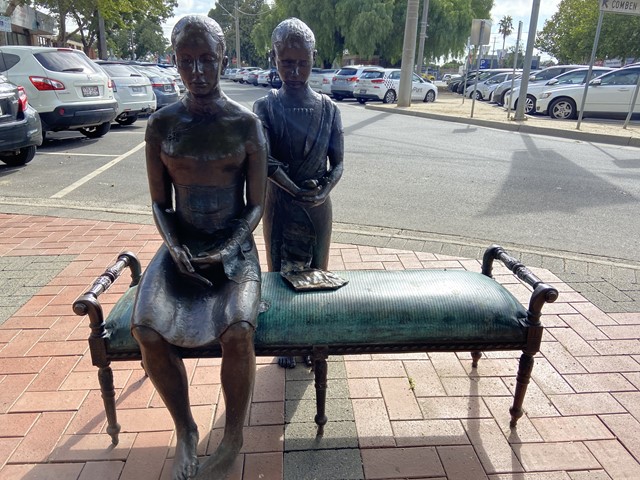
Oasis is a bronze sculpture depicting a mother and a child waiting. The artwork reinforced that the Centre is a meeting place with the two figures apparently waiting, the mother seated on an ornate seat and the daughter standing behind her.
Location: 8B Watton Street, Werribee.
Untitled Fountain by Helen Bodycomb (2000)
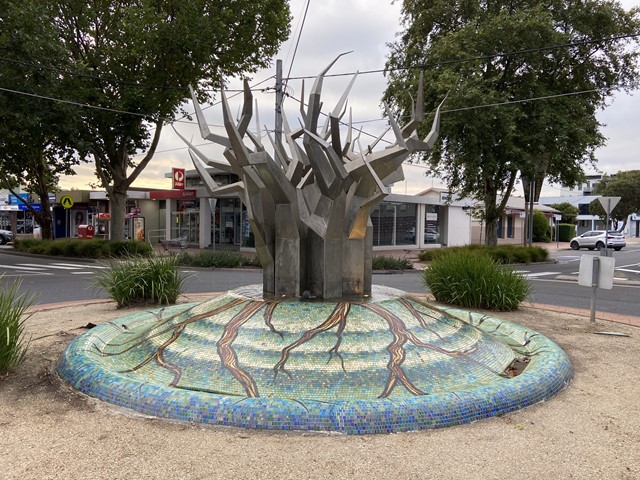
The stainless steel sculpture is the central focus of the fountain, taking its form from an inverted red gum tree root system. River red gums proliferate along the banks of Werribee River. The fountain component of the work features a series of vertical streams flowing from the tree root branches.
The characteristics of the sculptures design complement the modernist lines of the adjacent Wyndham Community Cultural Centre, thereby celebrating the interface of built and organic environments. The viewer's eye is led from the Cultural Centre to the River Walk at the end of Wedge Street, and to the Werribee River beyond.
The mosaic surrounding the sculpture suggests that the tree is encircled by water. The domed base, whilst serving as the sculptures plinth, depicts a radiating series of branches, gently corrugated by a series of three ripples. Patterning and colouring of the vascular branches, emanating from the base of the sculpture, represent the rich and complex indigenous heritage of the region. Water areas of the mosaic were rendered using a range of blue, green and gold hues from the Werribee River.
The design of the mosaic can be read as: A watery reflection of the root structure above it; a view of the sculpture as a tree seen from underwater; and a stylised representation of sections of the Werribee River and its tributaries, seen from an aerial perspective.
Helen explains that the symbolic meanings of the sculptural tree include the following: both the giver and manifestation; synthesis of heaven, earth and water; diversity in unity; and nourishment, shelter, support.
"The tree is a universal symbol of life and knowledge. As such, its root system is the primary channel for its strength and very survival. The root system was chosen as the subject for this artwork because of these meanings and because it is an aesthetically pleasing form that is simultaneously familiar and unfamiliar. It takes the form of a tree but it obviously not a tree." - Helen Bodycomb
Location: Cnr Watton Street and Wedge Street, Werribee.
Tree by Jackie Staude (1997)
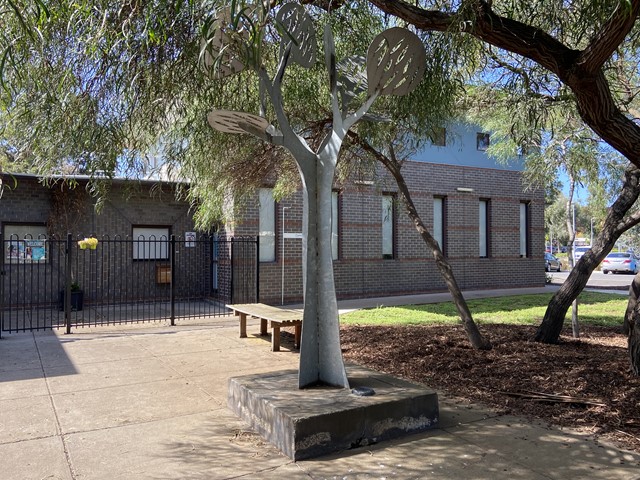
"Everyone is familiar with the tree. It is one of the most recognised shapes in the world. Children draw trees soon after they represent the human figure. The tree is a form of wonder, fascination, amusement and pleasure as well as function. The tree reminds us all of the scale of nature, of time before and beyond our own lives. A symbol of hope, growth, unity and shelter, it suggests the binds and roots of the family whilst inspiring the ambition to stand alone." - Jackie Staude
Location: Werribee West Community Centre, 37 Ballan Road, Werribee.
Pho 128 Restaurant Wall Mural by Tom Gerrard
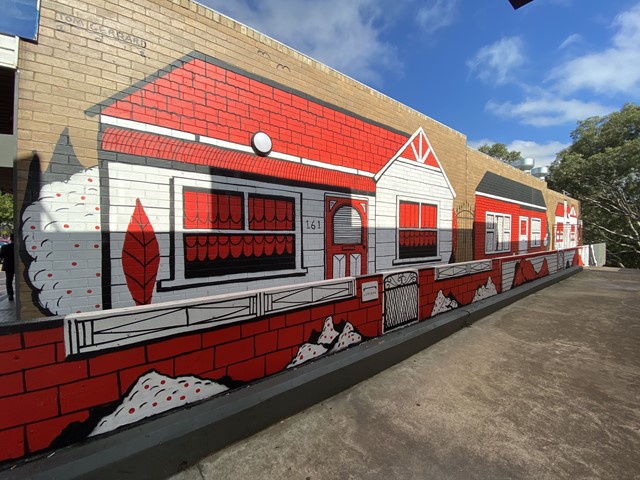
Artist Tom Gerrard, has turned a laneway into an artwork depicting a row of houses and shops, including local buildings.
Location: 72 Watton Street, Werribee.
Wyndham Library Wall Mural
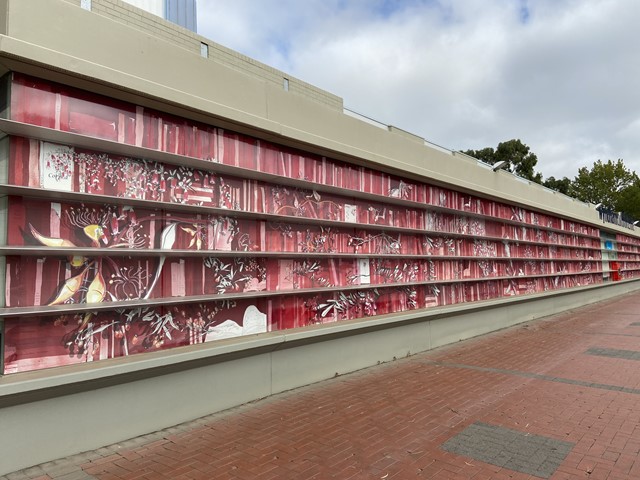
Location: Wedge Street South, Werribee.
Wyndham Park Community Centre Wall
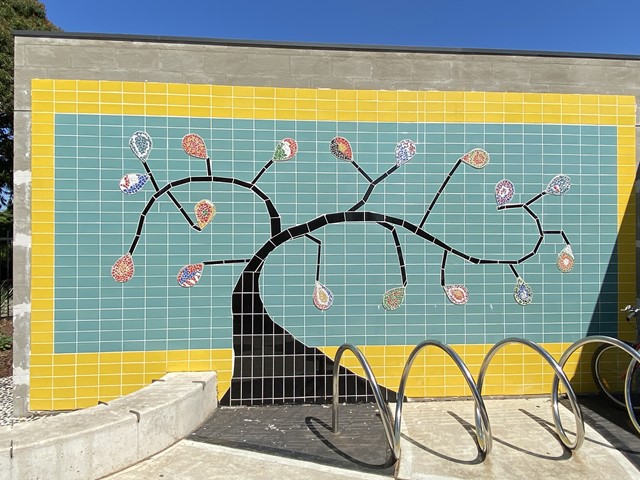
Location: Wyndham Park Community Centre, 55 Kookaburra Avenue, Werribee.
Parrakeet Road Shop Wall Mural
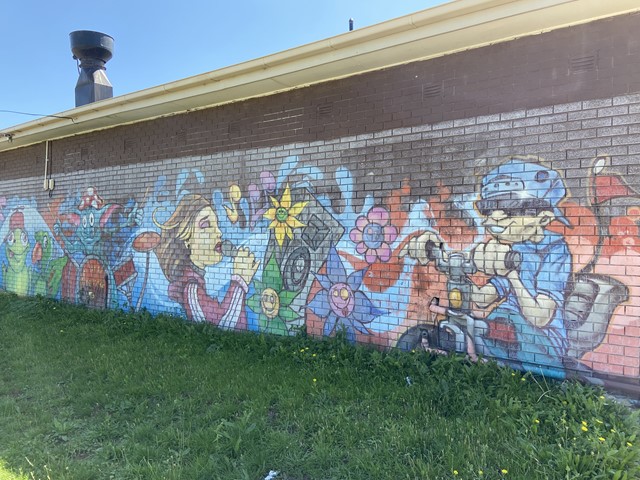
Location: Cnr Kookaburra Avenue and Parrakeet Road, Werribee.
Signal Box - Urban Geometry by Mila Poblete (2017)
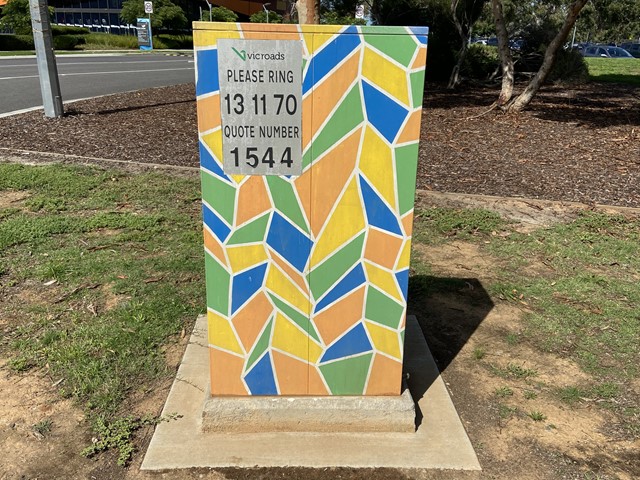
Geometric coloured design. Urban geometry shows basics shapes that we find everywhere in urban planning, approaching to space in a different creative way.
Location: 35 Ballan Road, Werribee.
Signal Box - Zero Bouquet by Shannon Keane (2017)
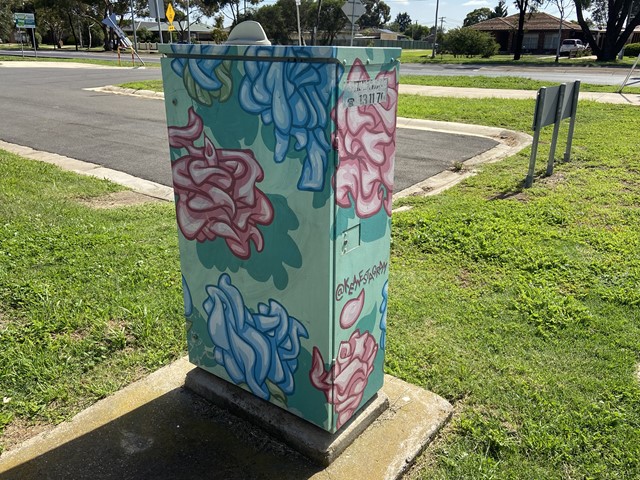
Flowers floating around.
Location: 47 Ballan Road, Werribee.
Signal Box - Ficus Trees by Daniel Worth (2017)
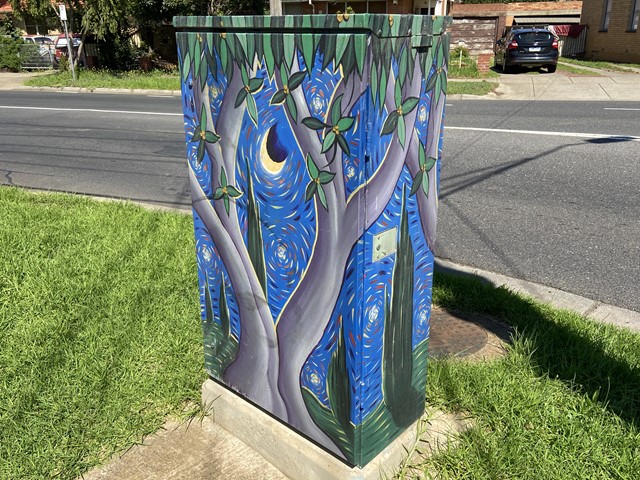
The painting reflects the park lands and green areas close by.
Location: Cnr Shaws Road and Market Road, Werribee.
Signal Box by Michelle Baginski (2017)
.jpg)
Interconnected and dependent on the strength and structure of the trees that stand tall in Werribee.
Location: Cnr Tarneit Road and Parramatta Road, Werribee
Signal Box - A House for the Vacant Lot by Daniel Worth (2017)
.jpg)
Next to this site is an area that looks like it has been vacant for some time. I thought by painting houses at the location you can image what might have been or what will be built on this site in the future.
Location: Cnr Cottrell Street and Market Road, Werribee
Signal Box - Wyndham Leaves by Reuben Duffy (2017)
.jpg)
Wyndham leaves inspired by the vegetation in the area.
Location: Cnr Derrimut Road and Warringa Crescent, Werribee
Signal Box - The Great Race by Kevin Fregon (2017)
.jpg)
Lawnmowers battle each other in an endless race of gladiatorial proportions in the hope of being crowned victor.
Location: Cnr Princes Highway Tyrone Street, Werribee
Signal Box - Fundamental Lines by Michelle Baginski (2017)
.jpg)
With a nod to the structures built in the past by early communities, we recognise basic needs to be met today are the same - in this case, shelter to live, learn and socialise.
Location: Cnr Heaths Road and Rosella Avenue, Werribee
Wyndham Cultural Centre Carpark Mural by Ash Keating
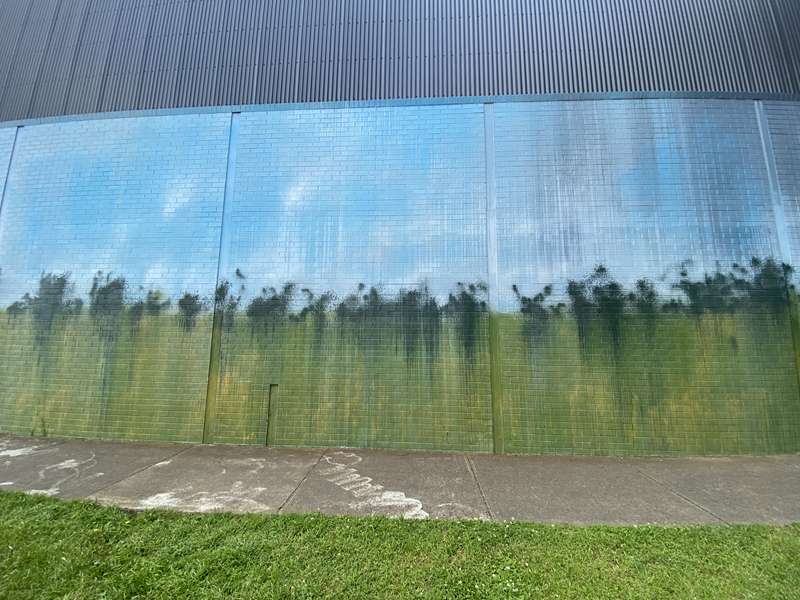
Location: 177 Watton Street, Werribee
Werribee South Area:
Boy by Matt Calvert (2007)
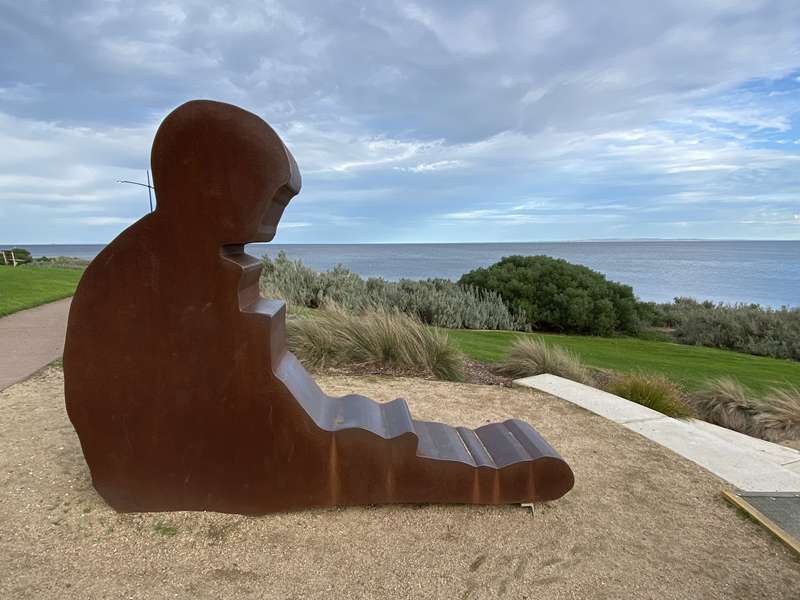
"A book written and illustrated in the 1960's in the signature "boy's own" style titled "I spy manual" is the basis for this work. It is a silhouetted figure of a lone child, sitting on the grass lost in his thoughts. The figure was taken from a scene in the Annual of children playing, but the boy is left out of a game, to ponder his relevance in an increasingly complicated and difficult world." - Matt Calvert
Location: 35 Beach Road, Werribee South
Williams Landing Area:
Centipede Electrical Box Mural
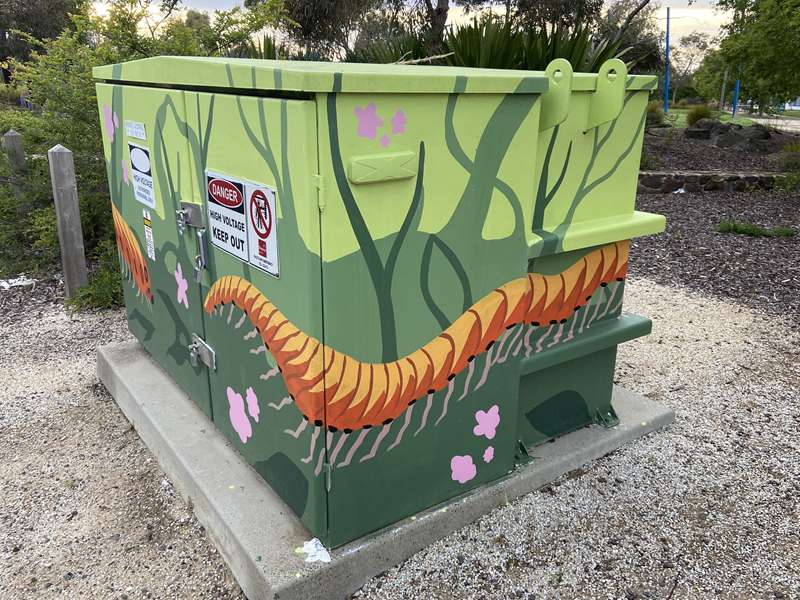
Location: 36 Mandrel Drive, Williams Landing
Rainbow Lorikeet Electrical Box Mural by David Lee Pereira
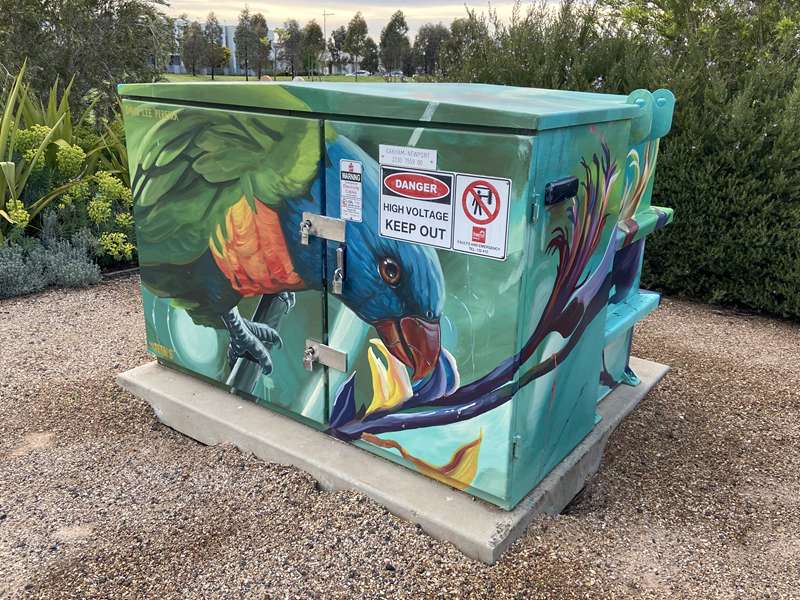
Location: 35 Oakham Drive, Williams Landing
Wyndham Vale Area:
Sensitive Chaos (Elements 1 to 6) by Darryl Cowie (2006)
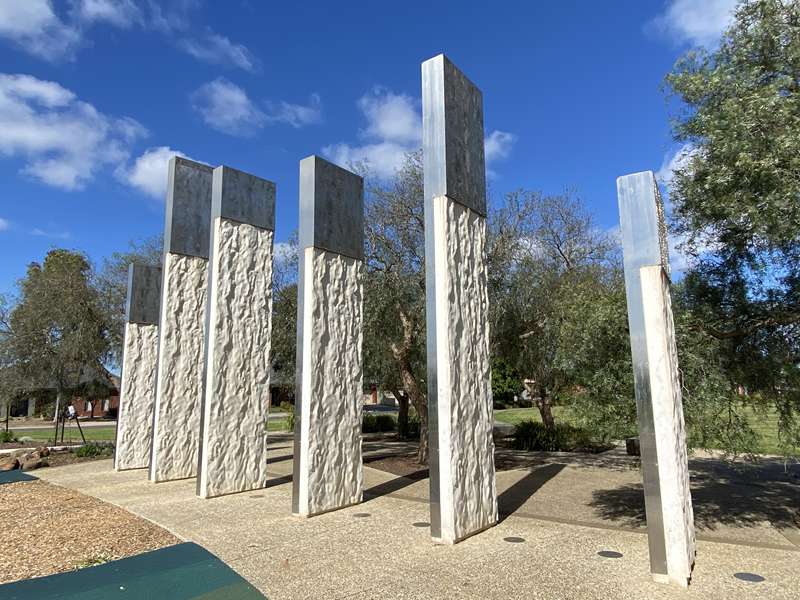
Location: Corner Haines Drive and Playford Drive, Wyndham Vale
The Guardians by Brigit Heller (2004)
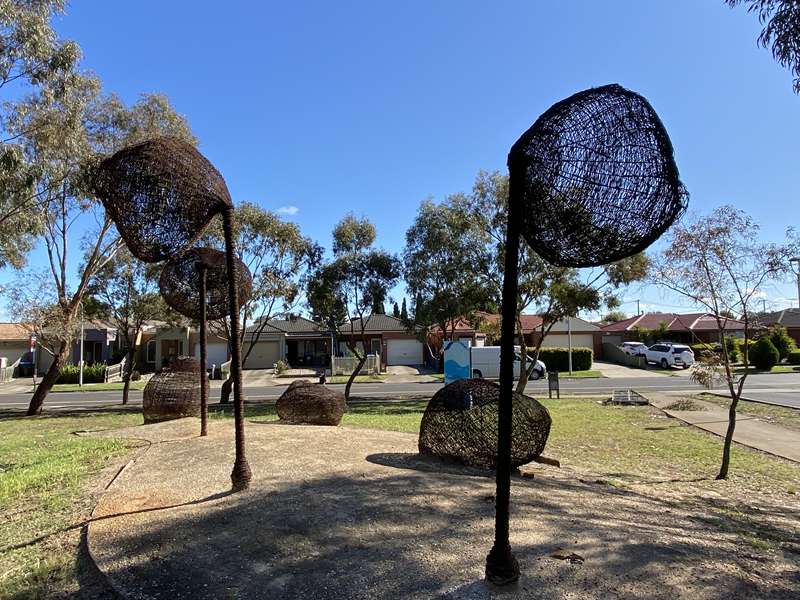
"In my work I normally use forms that occur in nature (nests, plants, trees etc.). Lately having used steel wire that is going to rust I have been able to become more ambitious with the scale of my work but also to create a contrast between the use of steel and its fragile, organic look. The shapes should evoke the viewer's curiosity; invite him/her to explore the different aspects of the work close up.
Part of the challenge with "the guardian" was to create an artwork that is going to belong to a very new environment and at the same time looks as though it has been there for a long time (which is hopefully going to happen after the landscape is going to settle down a bit). I felt that I wanted to create a somewhat organic, natural space in an urban environment - not only a visual but also a spiritual experience". - Brigit Heller
Location: Iramoo Community Centre, Honour Avenue, Wyndham Vale.
Untitled by Richard Walker (2007)
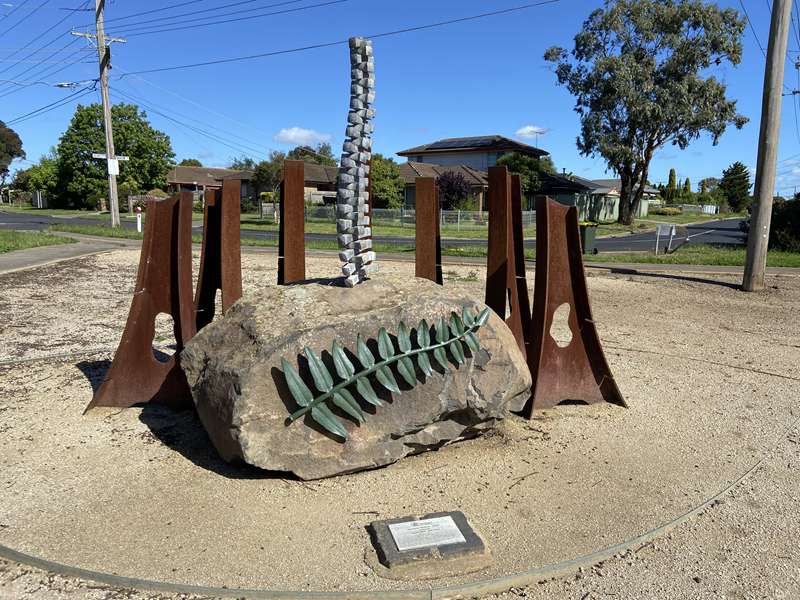
"My intentions for this project were to produce a bold sculpture with a strong organic feel and components that held meaning to the region. The most symbolic of the 4 components is the backbone, as 'Werribee' means backbone in the local aboriginal language. The large forged bones come together and highlight the importance of working together to provide support, just as in the community. The columns and the fern represent aspects of the local flora, red gums and the sickle fern respectively which can be found in the Wyndham/Werribee region. These elements are set into a local basalt rock which is the main rock in the region." - Richard Walker
Location: Skeleton Creek, Brougham Avenue and Olive Way, Wyndham Vale.
Floral and Bee Electrical Box Mural
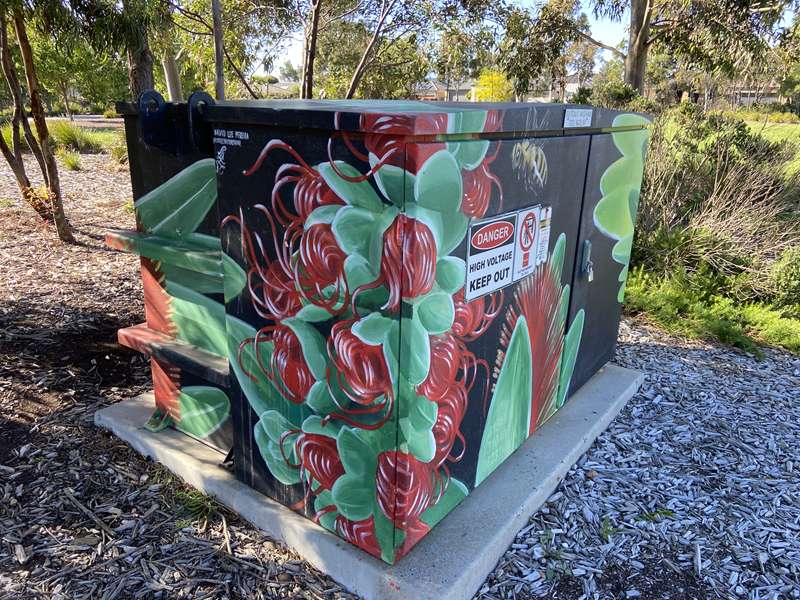
Location: 6 Boucaut Street, Wyndham Vale.
Map of Street Art Locations:
Web Links
→ Werribee Public Art Walking Tour








